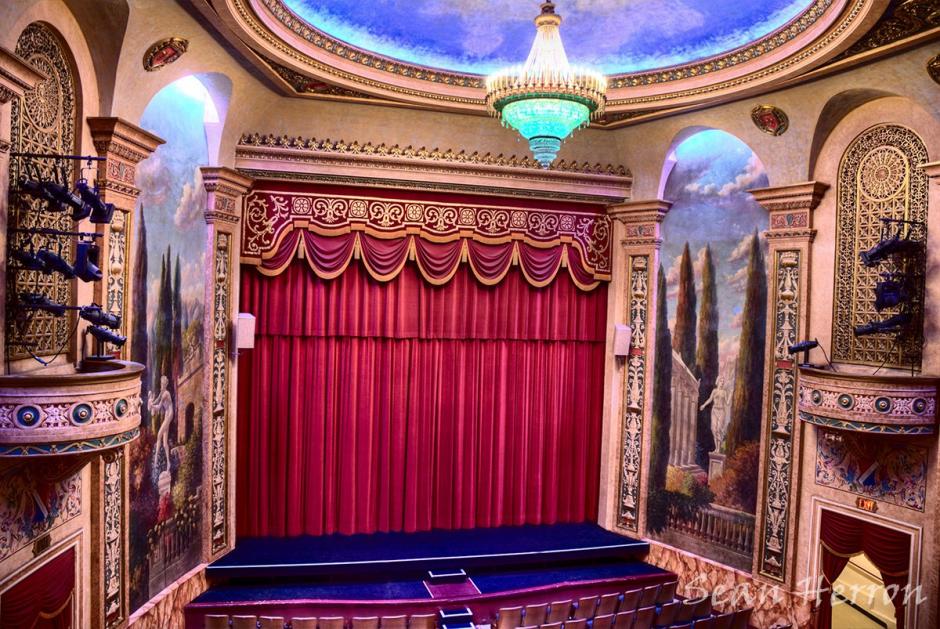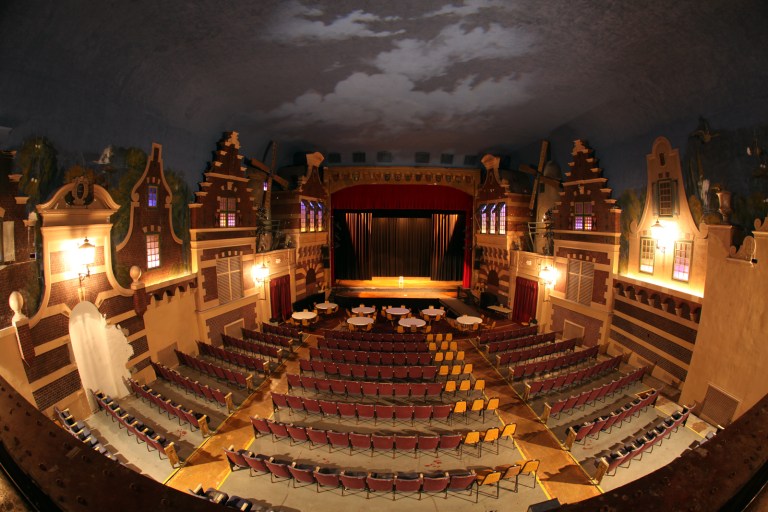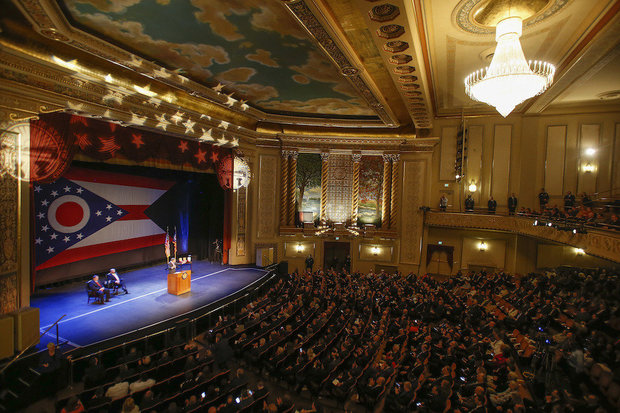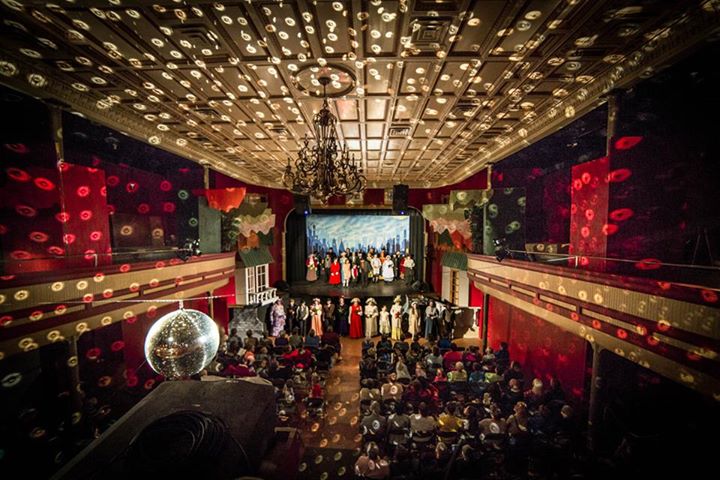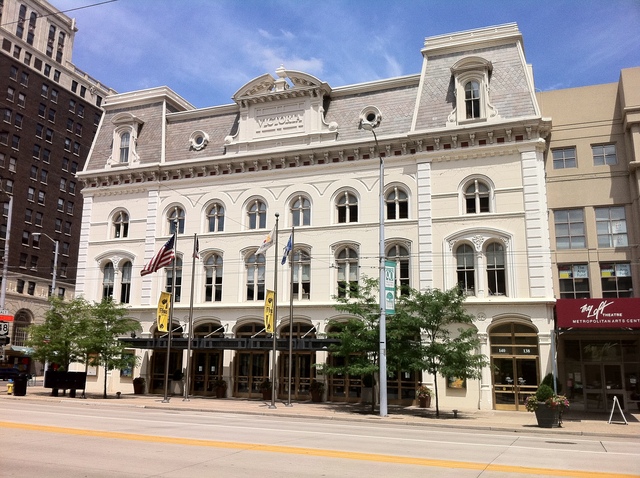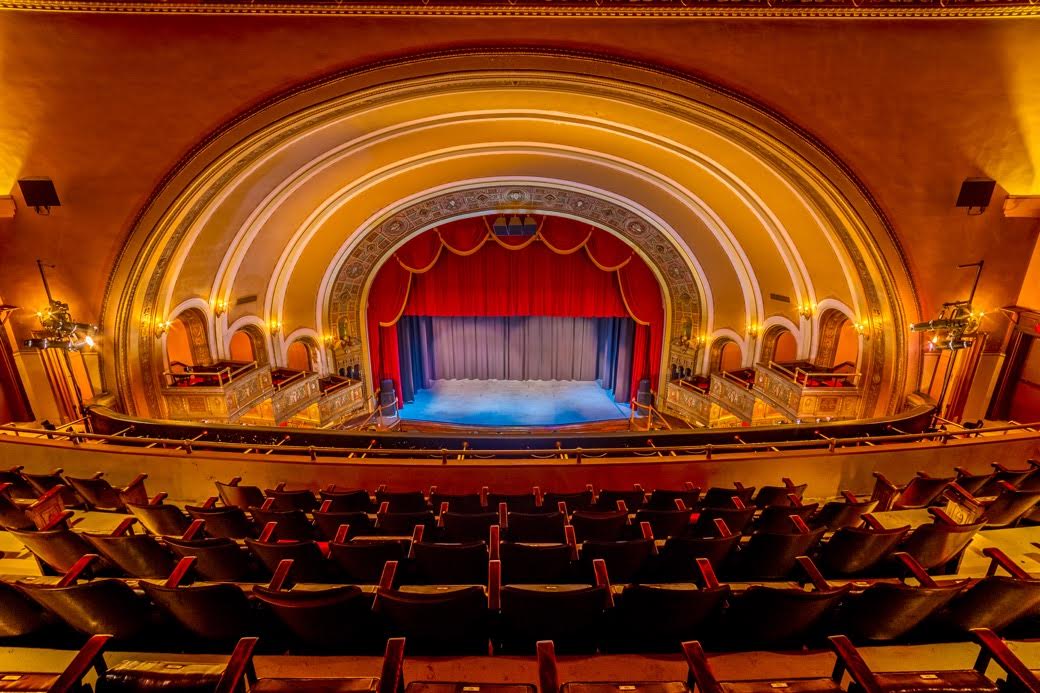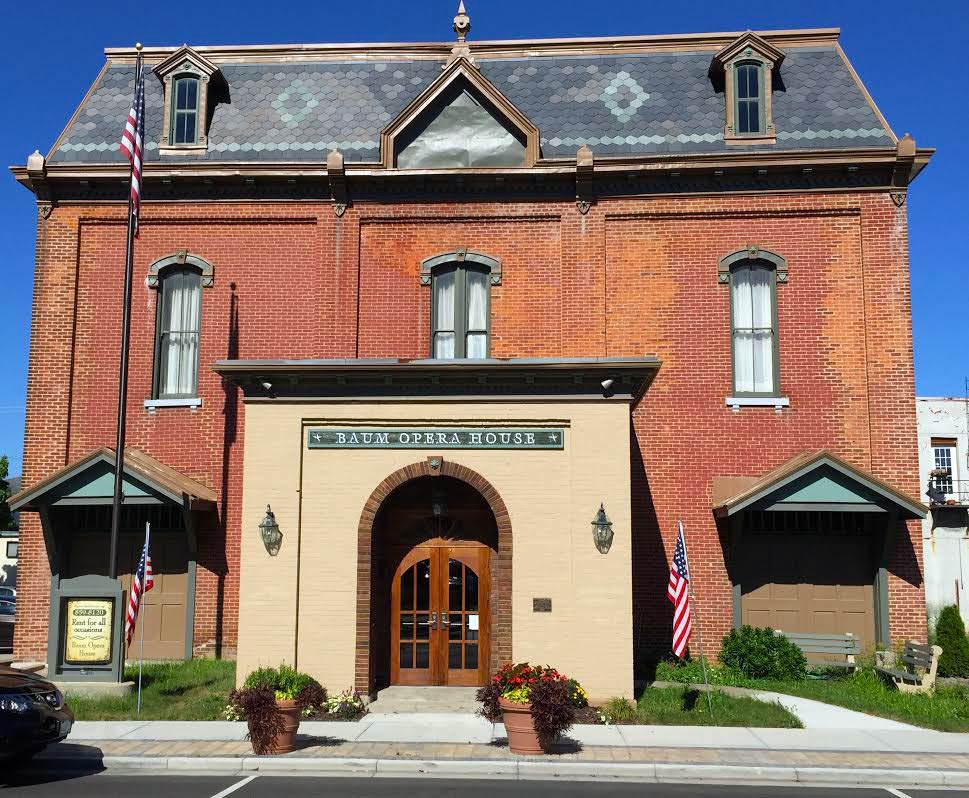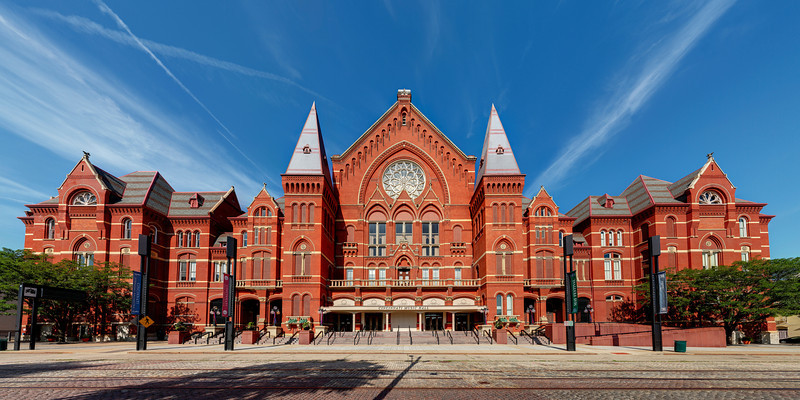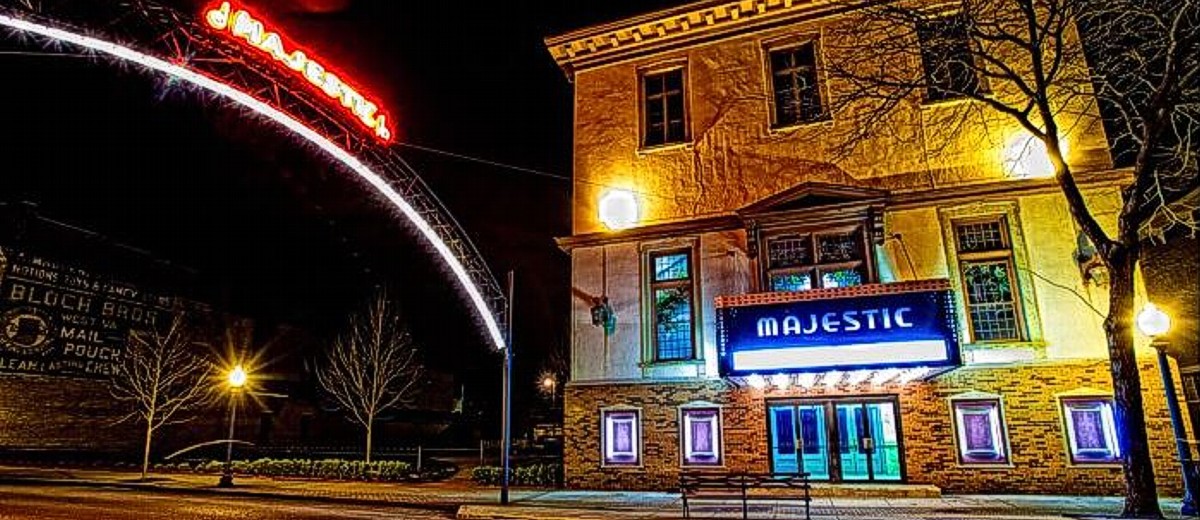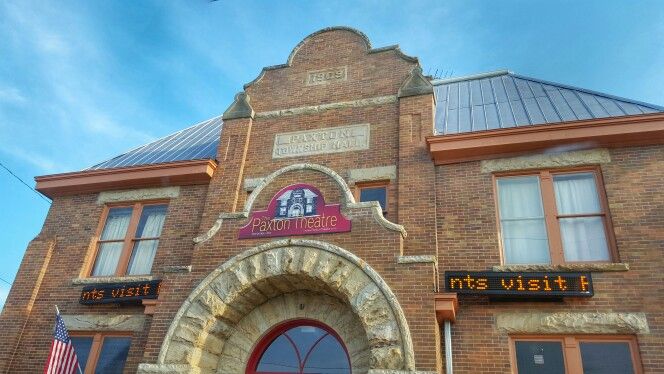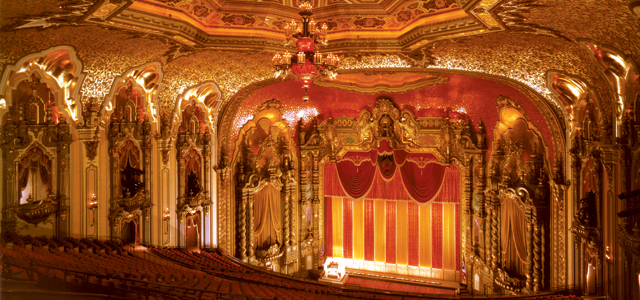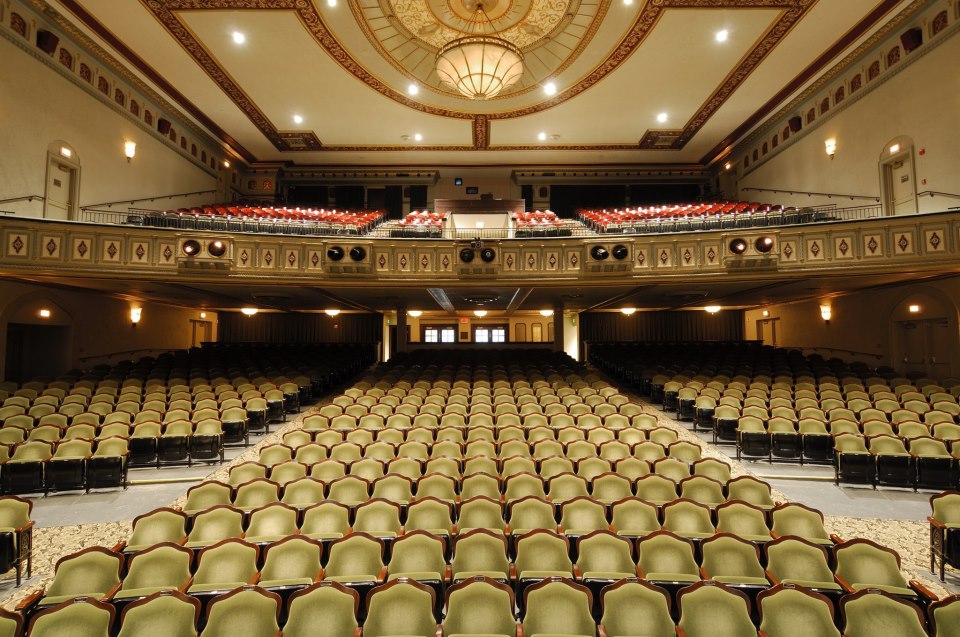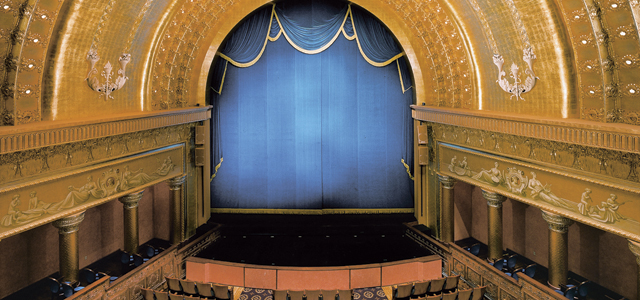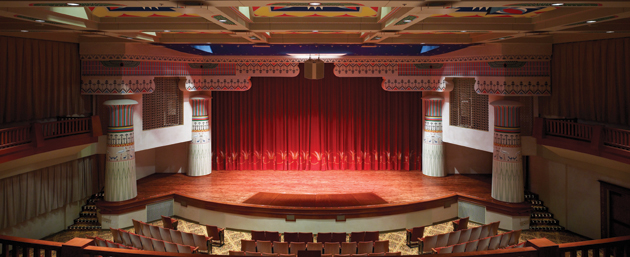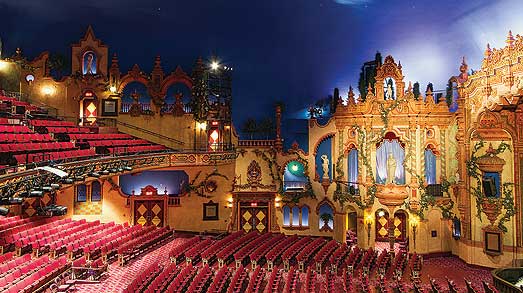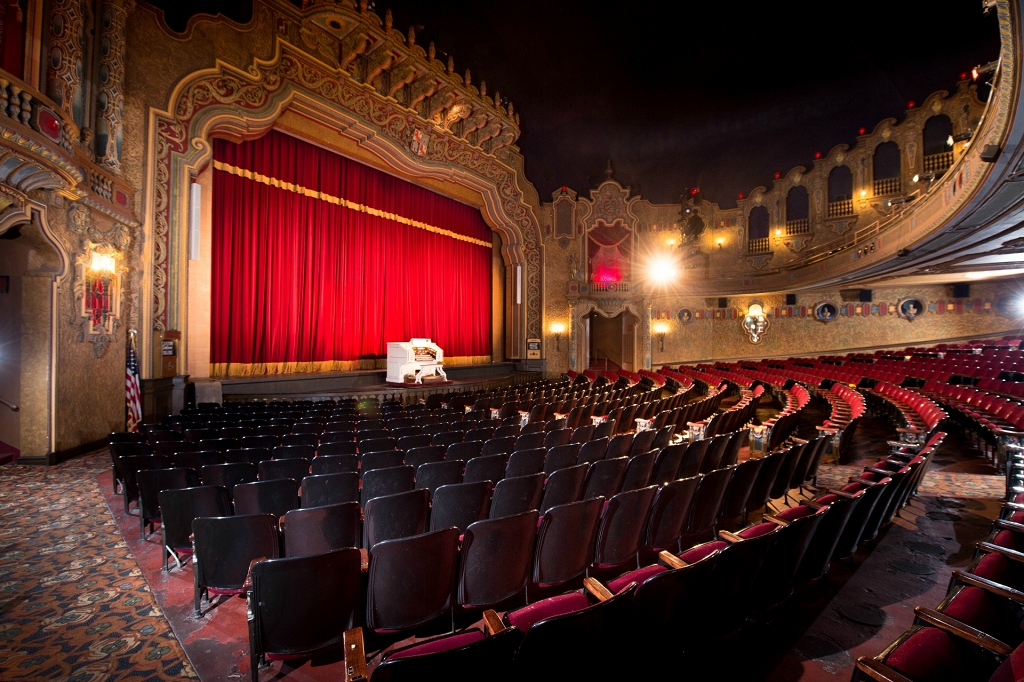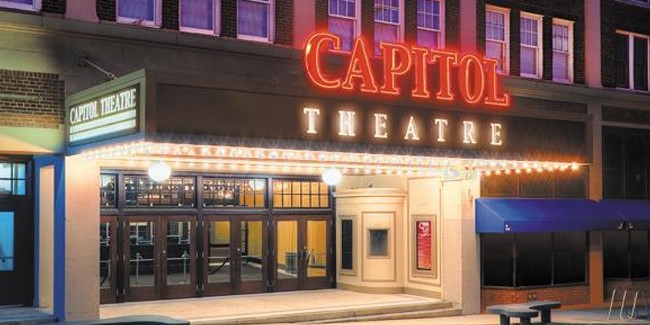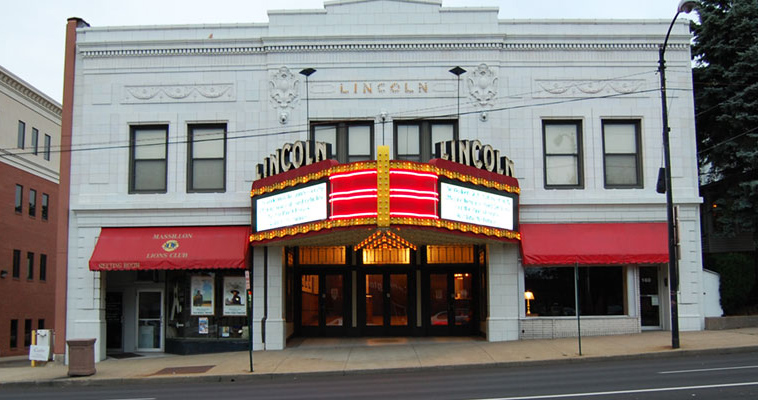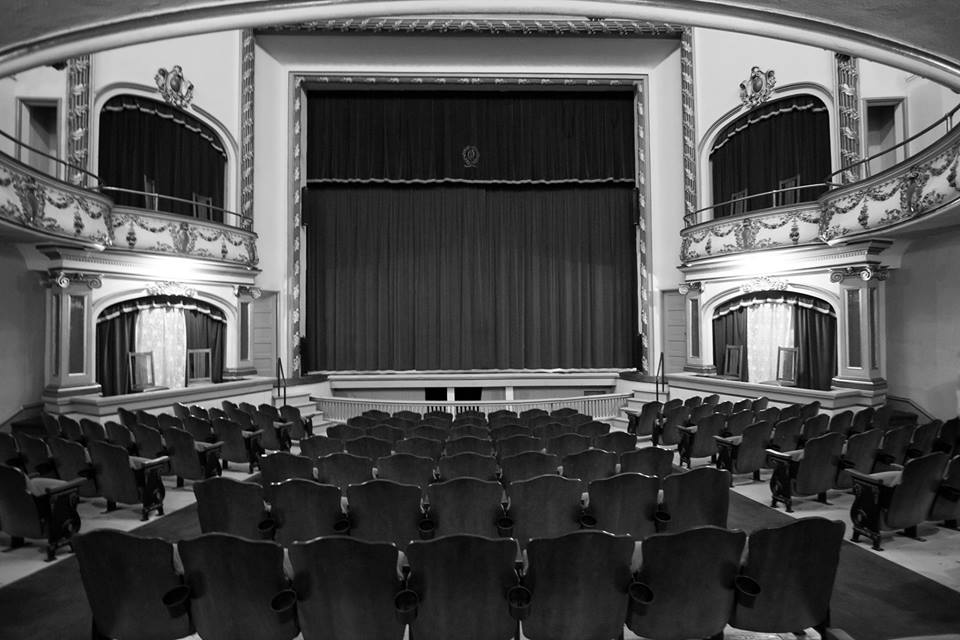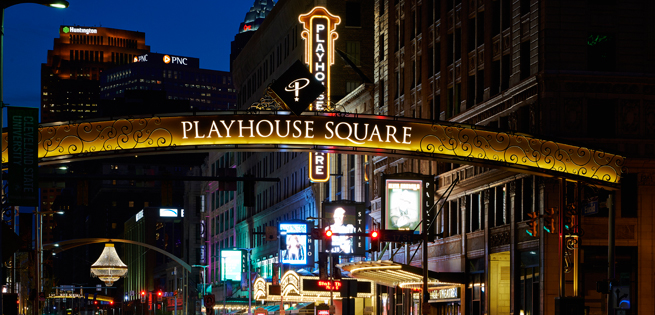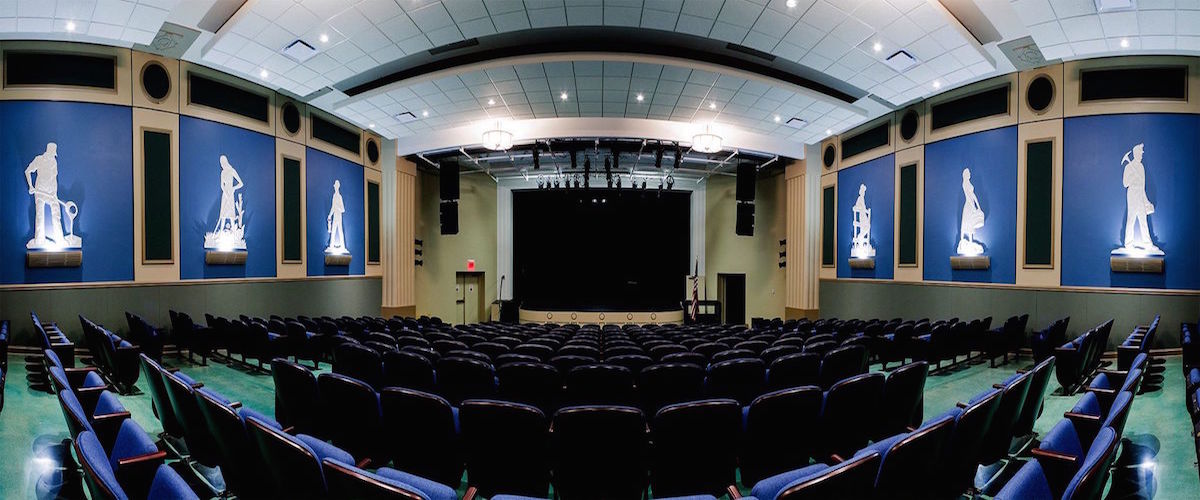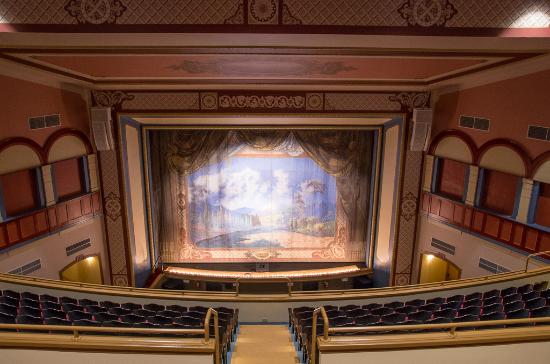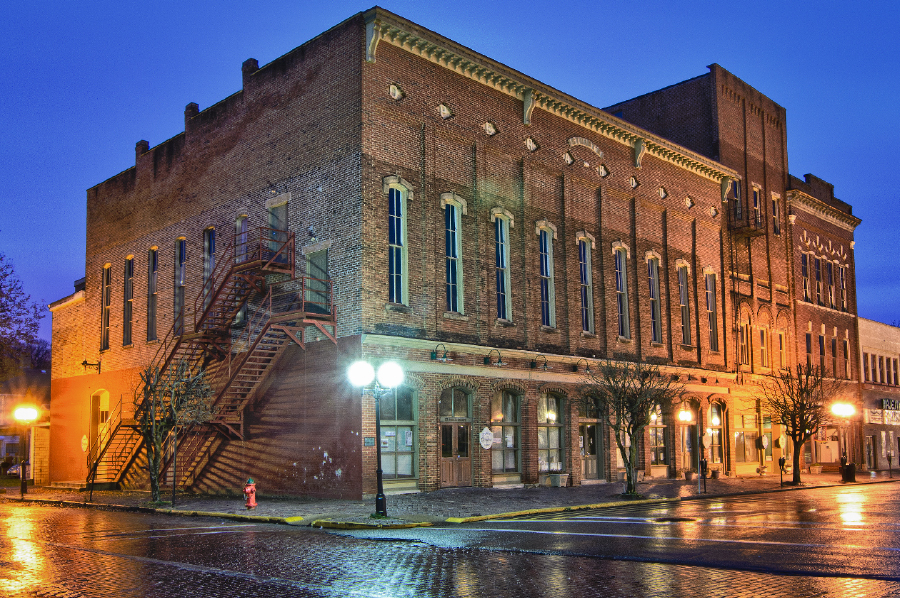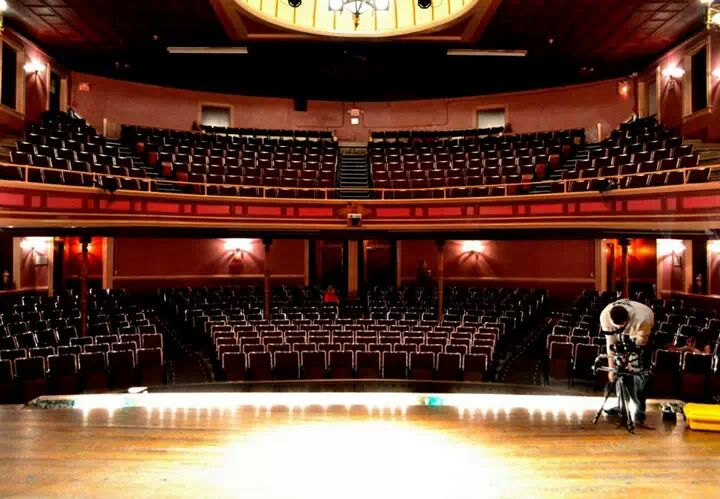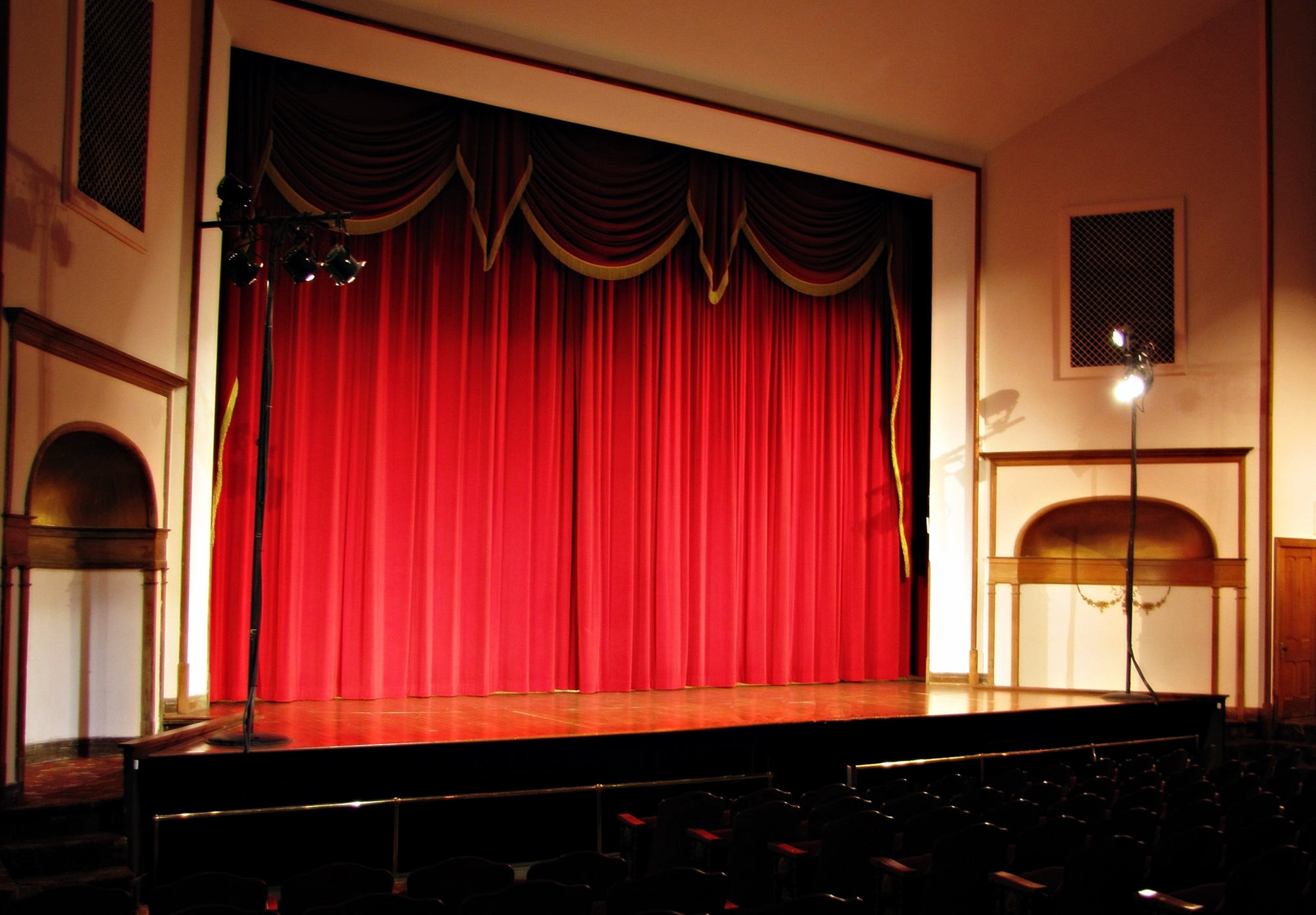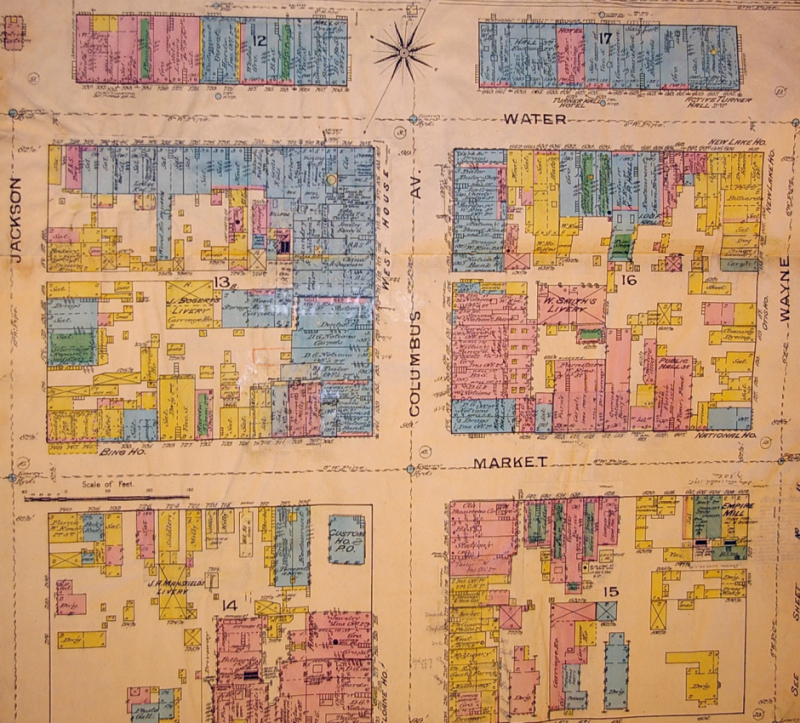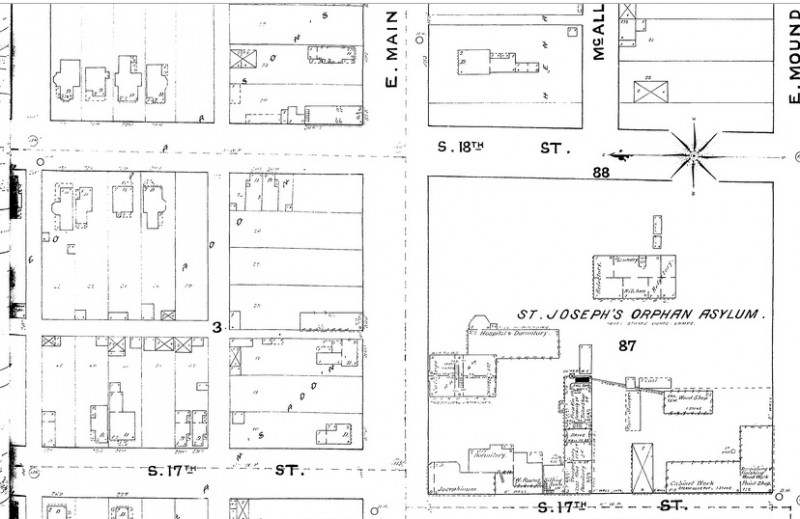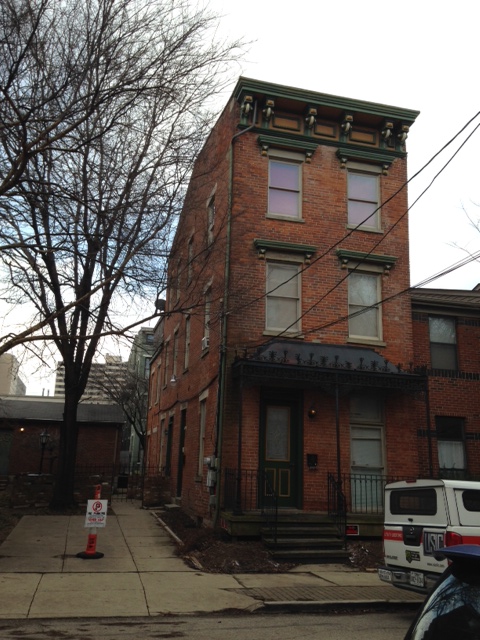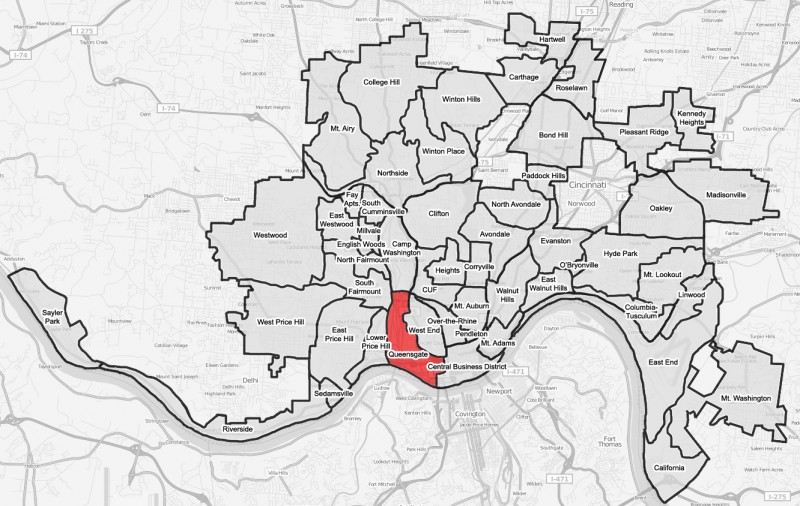And the winner is…
Congratulations to Ashley Combs of Middletown for winning our Preservation Month Photo Contest! Ashley’s winning entry will be featured on a future cover of Revitalize Ohio, plus we’ll honor her winning image at our Annual Conference this October in Cleveland. Thank you to everyone who entered a photo this year, and to everyone who voted!
Rustic Treasure (Bank Vault inside the Historic Goetz Tower)
The Goetz Tower is a seven-story Art Deco building that was constructed in 1930 and is located in the heart of Downtown Middletown, Ohio. This is a beautiful historic building that offers unique architectural features everywhere you turn inside and outside. Over the years the Goetz has survived decades of changes that have occurred in our City. We look forward to the future and bringing this space back to life to be enjoyed by all.
Middletown is currently in the process of revitalizing its downtown and has been very successful in bringing new businesses and people over the last two years. Once renovated this building will become another destination location for visitors as well as provide a home for new residents. Every downtown that has come back from neglect and abandonment has done so with a residential component downtown. The Goetz Tower is a crucial component in the revitalization of Downtown Middletown.
The City of Middletown believes that this building has the potential to be converted into a destination location for premier space for offices, retail, and restaurants as well as offer luxury apartments for those wanting to get away from the suburban lifestyle and reconnect with their community in a place like our up and coming downtown.
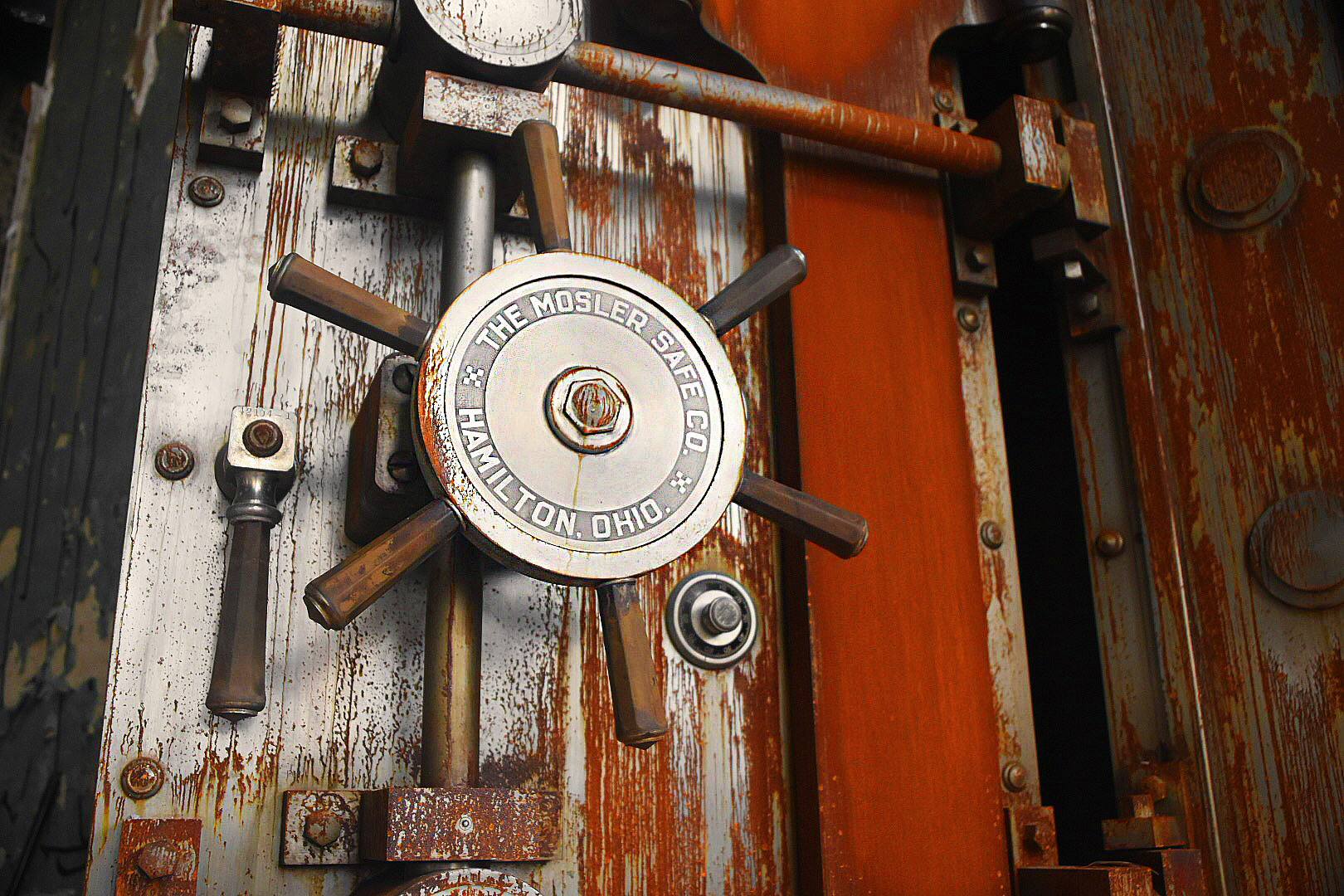
![]()
Preservation Month 2018 Photo Contest open for entries!
Happy Preservation Month! We’re celebrating Preservation Month with our 9th Annual Preservation Month Photo Contest, now open for entries! Our theme for 2018 is “This building isn’t empty…it’s full of opportunity” so we’re looking for entries showing great potential for reuse for our historic buildings.
When you get that perfect shot, submit it to us via our online submission form here. We’re allowing one entry per person, so you have to choose your favorite and get it to us! You can also post your entry on our Facebook wall using the hashtag #heritageohiophotocontest. You can also enter through Instagram, again using the hashtag #heritageohiophotocontest. Once our Preservation Committee chooses finalists, we’ll open the contest to online voting. Your vote will help us choose the winner!
Once again, this year’s winner will have their image featured on the cover of Revitalize Ohio. Happy (early) Preservation Month and may the best photo win!
Dates to remember:
Entries accepted: Monday, April 16-Monday, May 14
Finalists announced: Friday, May 18
Online voting for finalists: Monday, May 21-Tuesday May 29
Winner announced: Wednesday, May 30
Some guidelines to remember: be creative and original with your photo composition…we love photo entries depicting historic buildings in use (or, for this year, historic buildings waiting to be in use); make sure your image highlights Ohio subject matter; and finally, use your best judgment as to whether or not you should get permission from the building owner before photographing your subject matter.
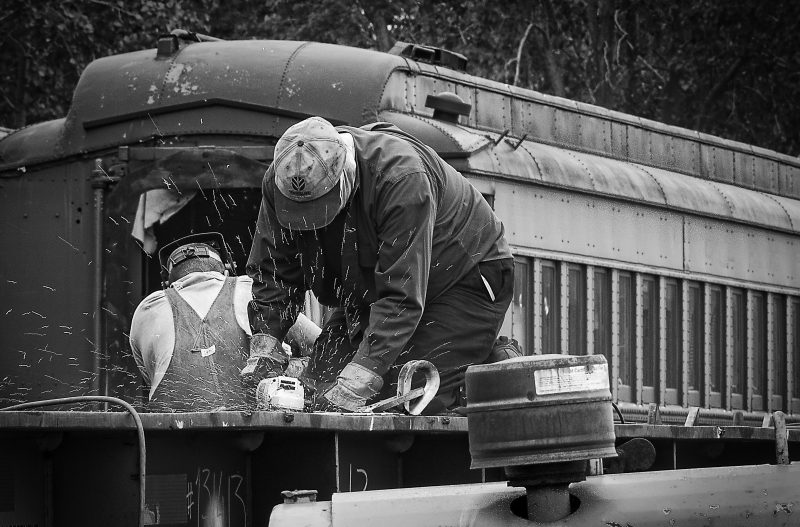
Maybe a photo of last year’s winning entry from Judith Khaner will help encourage your own ideas for a winning entry this year?
![]()
A Brief History of Columbus
October 11th, 2017 1 pm – 2 pm
Join Heritage Ohio and Columbus historian Ed Lentz for a webinar discussing some of the interesting histories of Ohio’s capital city. In preparation for Heritage Ohio’s Annual Conference the following week, learn a little about the city we will be exploring during various tours offered.
Heritage Ohio Members Register Here
Not a Member? Join Heritage Ohio now to get access.
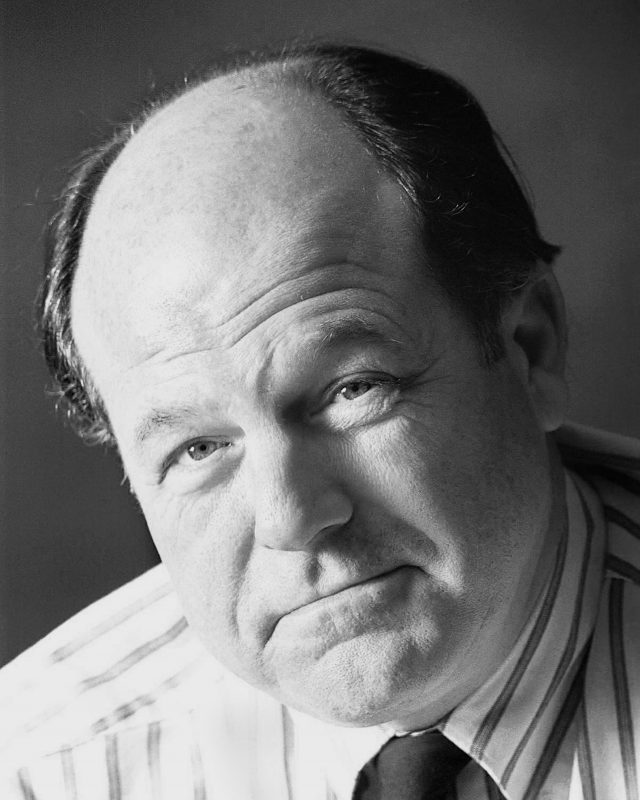 Ed Lentz has been teaching, writing and exploring the history of Central Ohio for more than fifty years. When not doing that sort of thing, he teaches from time to time at various local colleges and universities. He writes for local newspapers, consults in history and historic preservation and keeps company with his wife, two cats and occasionally visiting two children.
Ed Lentz has been teaching, writing and exploring the history of Central Ohio for more than fifty years. When not doing that sort of thing, he teaches from time to time at various local colleges and universities. He writes for local newspapers, consults in history and historic preservation and keeps company with his wife, two cats and occasionally visiting two children.
Ed worked at the Ohio Historical Society for a number of years and was Executive Director of the Columbus Landmarks Foundation from 1983 to 1988 and from 2013 to 2017.
Mr. Lentz holds degrees in history from Princeton University and The Ohio State University. He has written a weekly column on Columbus history for the This Week Community Newspapers since 1992. He has been Historical Consultant to Columbus Neighborhoods programming on WOSU Public Media since 2010. He is the author of several books, including Columbus – The Story of a City ( 2003), A Home of Their Own (2010) and Historic Columbus (2012).
![]()
The Most Stunning Historic Theatres in Ohio
We love seeing historic theatres restored in Ohio to their former glory and once again a proud centerpiece of the community. Can you believe some of these theatres were once threatened with demolition to make way for parking lots? Thanks to the work of preservationists across the state, you can still visit these stunning Ohio historic theatres.
Northwest
The Ritz Theatre – Tiffin
The Ritz Theatre opened to great fanfare in December of 1928 in downtown Tiffin. The theatre’s design takes elements from the Italian Renaissance, including an artistic interpretation of a Roman villa in the concert hall. The theatre was renovated in 1998, bringing the theatre back to its original charm and elegance.
Today, the theatre offers a variety of performances including live music, classic films, and theatrical pieces. See the current schedule here.
The Holland Theatre – Bellefontaine
The Holland Theatre is one of the more uniquely designed theatres in Ohio. Both inside and out, the theatre transport the visitor to Holland, with classic Flemish design, including a dutch village-scape in the interior. The theatre opened in 1931 as The Schine’s Holland Theatre. While some alterations have occurred over the years, much of the original splendor of the theatre is intact and ready to wow.
With numerous performance throughout the year, you will have plenty of opportunities to visit the theatre. See the current schedule here.
The Sandusky State Theatre – Sandusky
The Sandusky State Theatre opened in 1938 as The Schine Theatre with a showing of Night Watch. The theatre fell into disrepair in the 1960s, but was extensively renovated in 1990. Theatre hosted a performance of Michael Bolton to celebrate its 75th anniversary. For its centennial anniversary, the Sandusky State Theatre hopes to be completely renovated to its original splendor.
The Sandusky State Theatre offers a wide variety of programming. See their upcoming events here.
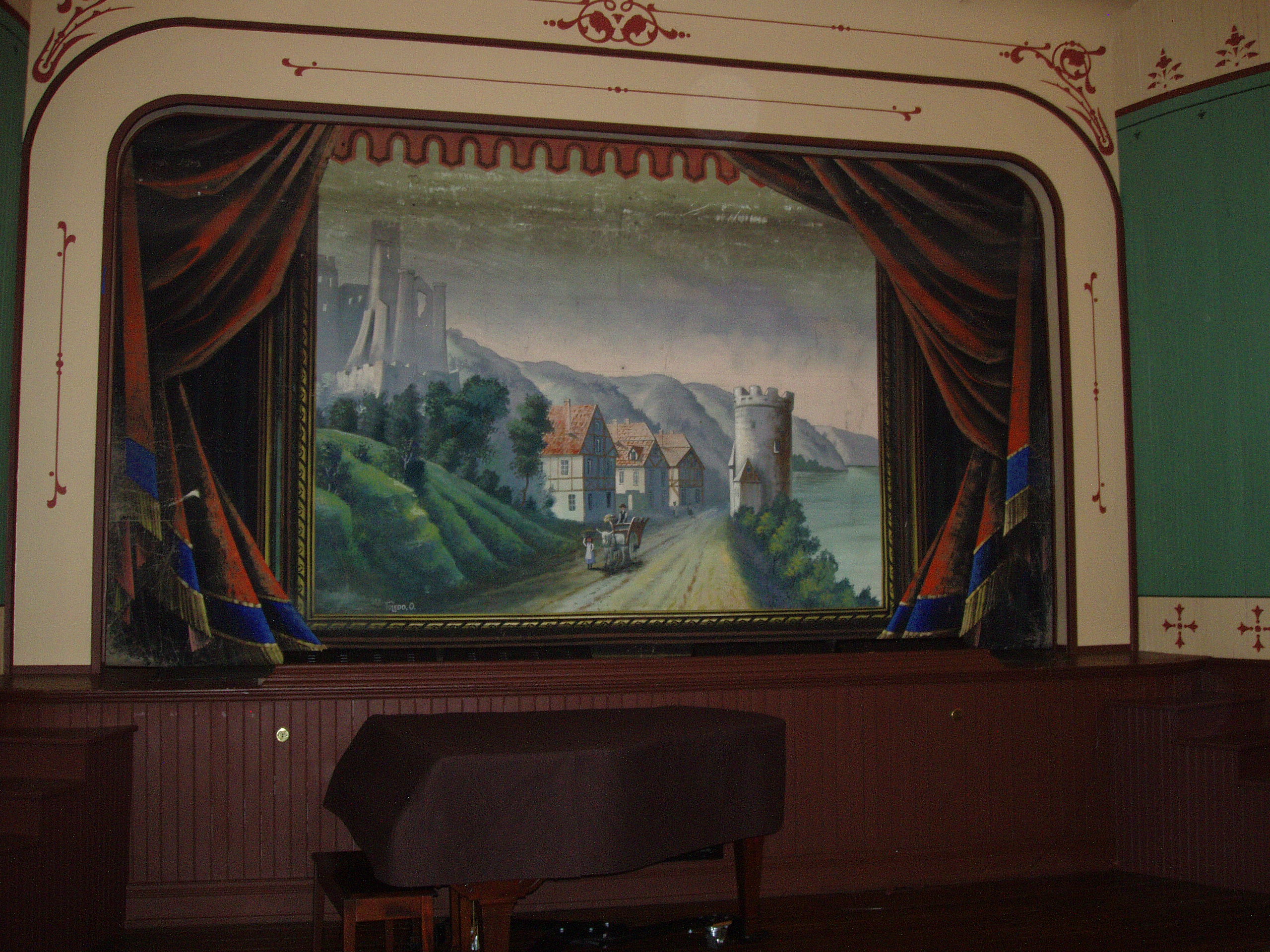
The Pemberville Opera House – Pemberville
Resting on the second floor of the Pemberville Town Hall, the Pemberville Opera House opened to Jeptha’s Daughter, an adaptation of the Biblical story. The opera house was wildly popular in before WWII, especially after electric lights were added in 1899. Following years of neglect, renovations were started in 1998 to return the opera house to use.
Today, the Pemberville Opera House hosts several productions every year. See their current schedule at the link above.
The Huber Opera House & Event Center – Hicksville
The Huber Opera House started life as Mackey’s Brick Hotel in downtown Hicksville in 1882. After a fire destroyed the Pettit Opera House, the hotel was converted to an opera house in 1895. The opera house remained the center of community life well into the 1970s, before it became rundown. In 1999, a coalition of community members and businesses purchased the opera house, giving it a new lease on life.
You have plenty of opportunities to visit The Huber Opera House. See their current schedule here.
Southwest
The Victoria Theatre – Dayton
The Victoria Theatre in Dayton traces its roots to The Turner Opera House, opened in 1866. The Turner only existed a few years before being destroyed in a fire. After the opera house was rebuilt, it underwent a series of name changes: The Music Hall in 1871, The Grand Opera House in 1885, The Victoria Opera House in 1899, and The Victoria Theatre in 1902. After surviving the Flood of 1913, another fire destroyed the building in 1918. After being rebuilt, it became The Victory Theatre. It thrived up into the late 1950s, but was marked for demolition in 1972. The community stepped up to save the theatre and the Victory Theatre Association began renovations in 1976. The theatre was transferred to the Arts Center Association in 1988 and was renamed again, back to The Victoria Theatre.
The Victoria Theatre offers extensive programming throughout the year. You can see their current schedule here.
The Murphy Theatre – Wilmington
The Murphy Theatre opened in downtown Wilmington in 1918. After operating as a Vaudeville theater, it was leased to Chakeres Theaters in 1929. In 1989, the theatre was purchased by a local group of citizens who sold stock options to save the theatre. Since the great work of these enterprising citizens, the Murphy Theatre continues to operate to this day.
The Murphy Theatre has numerous films and presentations every month. See their current schedule here.
The Baum Opera House – Miamisburg
The Star City Opera House was constructed by German immigrant Charles Baum in 1884, and quickly became the epicenter of life in Miamisburg. Like many other theaters and opera houses after WWII, it went through a series of name changes and uses, including housing a dinner theater, bowling alley, skating rink, and a few bars. It was slated for demolition in the early 1990s, but was purchased at a Sheriff’s sale. Since then, the Baum Opera House Association has managed the opera house and has fully renovated and restored the space to its former glory.
The Baum Opera House hosts several plays, musicals, and dances throughout the year. See their current schedule here.
The Cincinnati Music Hall – Cincinnati
Music Hall opened with a performance of Christoph Willibald Gluck’s Alceste in 1878. More commonly known as Cincinnati Music Hall, the concert hall is the defining structure of Washington Park in Cincinnati. With the decline of the Over-The-Rhine neighborhood, Music Hall’s future came into doubt. It was listed on the 2006 National Trust for Historic Preservation‘s 11 Most Endangered List. Through a grant from the City of Cincinnati, The Ohio Historic Preservation Tax Credit Program, and the generous donations of thousands of people, Music Hall has recently been renovated and will continue to serenade Cincinnati.
To see the current schedule of events at Music Hall, click here.
The Majestic Theatre – Chillicothe
The building that currently houses The Majestic Theatre was built in 1853 as a Masonic Hall. In 1876, the Masons designed an opera house to be built within the Masonic Hall. This opera house became the foundation for The Majestic. In 1904, the Masonic Hall and Opera House were sold, and sold again in 1915. The new owners changed the name of the theater to The Majestic Theatre and it soon became a cinema. After a sale of the building in the 1970s, the structure was renovated, and in 1990, the current non-profit association took control of the theatre.
Today, the theatre still shows films, as well as live performances. You can see the theatre’s full schedule of events here.
Paxton Theatre – Bainbridge
The Paxton Theatre is located on the upper floor of the Paxton Township Hall, opening around 1910. Soon after opening, the space was leased to show motion pictures, continuing under different operators until the early 1950s. In later years it was used as rental and entertainment space. In 1992, it was sold to host the Paint Valley Jamboree, which still takes place in the theatre. The building was recently sold and the current owners plan to make it the center of the community for years to come.
The Paxton Theatre continues to host the Paint Valley Jamboree, as well as numerous other musical guests and Shrek Jr. See all of the Paxton’s events here.
Central
The Ohio Theatre – Columbus
The Spanish Baroque-style Ohio Theatre opened as a Loew’s movie house in 1928. Opening at the end of the silent era of film, the theatre boasted its own orchestra and theater organ. The Ohio remained a cinema until the early 1960s and was threated with demolition by the end of the decade. The citizen-led “Save the Ohio’ campaign raised over $2M in less than a year and the Columbus Association for Performing Arts (CAPA) purchased the theatre. Today, the Ohio Theatre is the crown jewel of Columbus theatres, and hosts The Columbus Symphony Orchestra, BalletMet, The Broadway Series, and more than 100 CAPA events each year.
See CAPAs current schedule here.
The Midland Theatre – Newark
Opened in 1928, The Midland Theatre began its life showing Vaudeville shows and silent films. Interestingly, it was only a week later that the theatre premiered its first “talkie”. The theatre quickly transitioned into a full-time cimema, rotating films on a 3-day schedule. After years of decline, the theatre closed after the Blizzard of ’78 killed the boiler in the theatre. In 1992, The Longaberger Company purchased the theatre and renovated it. It entrusted the theatre to The Newark Midland Theatre Association to be stewards to the theatre and to provide quality programming for Newark.
Today, The Midland Theatre shows a variety of performances including live music and musicals. To see the Midland’s schedule, click here.
The Southern Theatre – Columbus
Just a few blocks south of The Ohio Theatre is another fantastic theater in downtown Columbus. Opened in 1896, the Great Southern Fireproof Hotel and Opera House filled a large gap in theaters in downtown. In the years prior to construction, 5 theaters were lost to fires in just 4 years. Other than being “fireproof”, meaning it was constructed with “fireproof” tile, brick, iron, steel, and concrete, the theatre was one of the first commercial buildings in Columbus to use electric lighting. In 1931, the theatre was converted to a cinema. After years of struggling, the theatre was closed in 1979. In 1982, the Great Southern Hotel was purchased and the owners offered the theatre to CAPA. After a combined effort of state and city funding, as well as donations from numerous donors and businesses, the Southern Theatre reopened in 1998.
See CAPAs current schedule here.
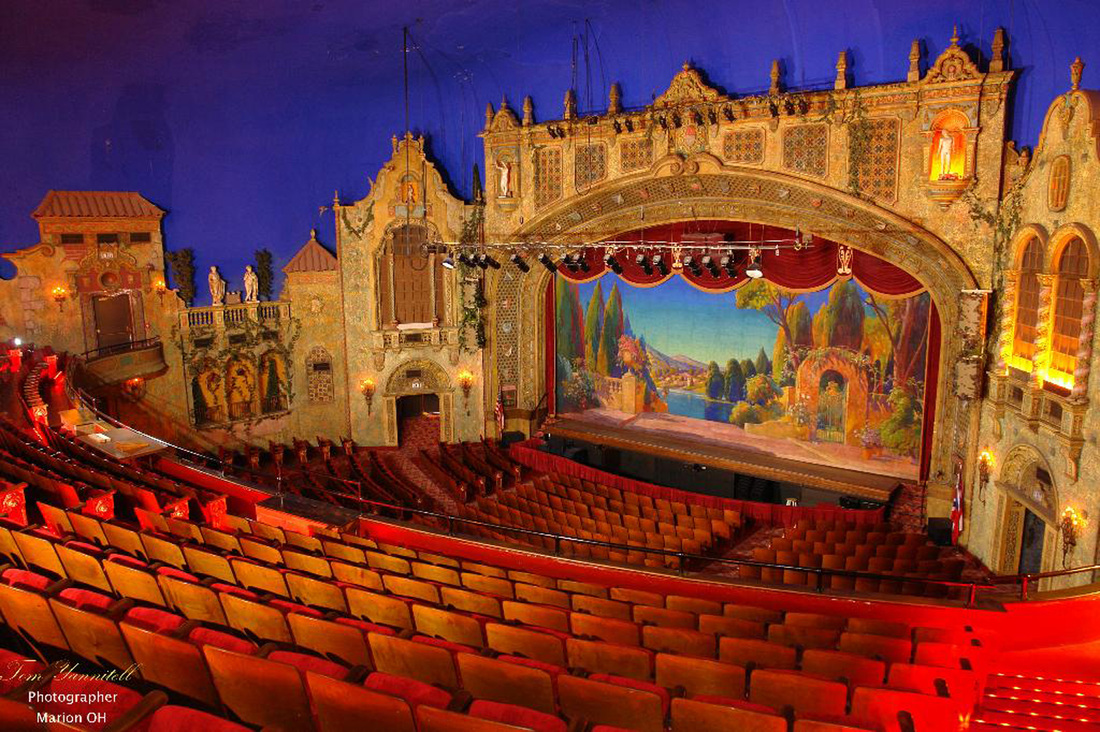
The Marion Palace Theatre – Marion
The Marion Palace opened as a cinema and Vaudeville theater in 1928, premiering with 4 Vaudeville acts and the film, Excess Baggage. The theatre is designed in Spanish Colonial Revival-style, and has several Roman and Greek statues designed by Pietro Caproni. Following several successful years as a cinema and multiple owners, the theatre needed extensive work to maintain its splendor. In the mid-1970s, a group of business owners, dubbed The Palace Guard, started a funding campaign to revitalize the theatre. The Palace Cultural Arts Association has operated the Marion Palace Theatre since then, and continues to provide new and exciting performances for Marion.
The Marion Palace Theatre shows films and live performances several times a month. See their schedule here.
The Lincoln Theatre – Columbus
Located just to the east of downtown Columbus, in the historic African-American neighborhood of King-Lincoln Bronzeville, is The Lincoln Theatre. Opened in 1928 as The Ogden Theatre, the Egyptian Revival theatre originally was used for Vaudeville performances and musical acts, but quickly transitioned into a cinema. It was renamed The Lincoln Theatre in 1939. Following several hard years, the theatre was closed in the early 1970s. The theatre reopened in 2009, with funding assistance from The City of Columbus and Federal Historic Preservation Tax Credits, and was widely seen as a catalytic revitalization project for the neighborhood.
See CAPAs current schedule here.
Northeast
The Akron Civic Theatre – Akron
In 1919, construction of a new theatre began in downtown Akron called The Hippodrome. In addition to a theatre, there were 30 planned shops inside an arcade. The project went bankrupt before it was complete. Soon after, Marcus Loew purchased the partially constructed Hippodrome and completed the newest Loew’s Theatre in Akron, designed by architect John Eberson. The interior is designed to resemble a Moorish castle, with Mediterranean elements throughout and is only one of a handful of surviving atmospheric theaters. After several ownership changes and nearly becoming a parking lot in the 1960s, the Akron Civic Theatre was extensively renovated in 2001, it reopened to fanfare with a new partnership with The University of Akron.
The Akron Civic Theatre has many live performances each month. See their current schedule here.
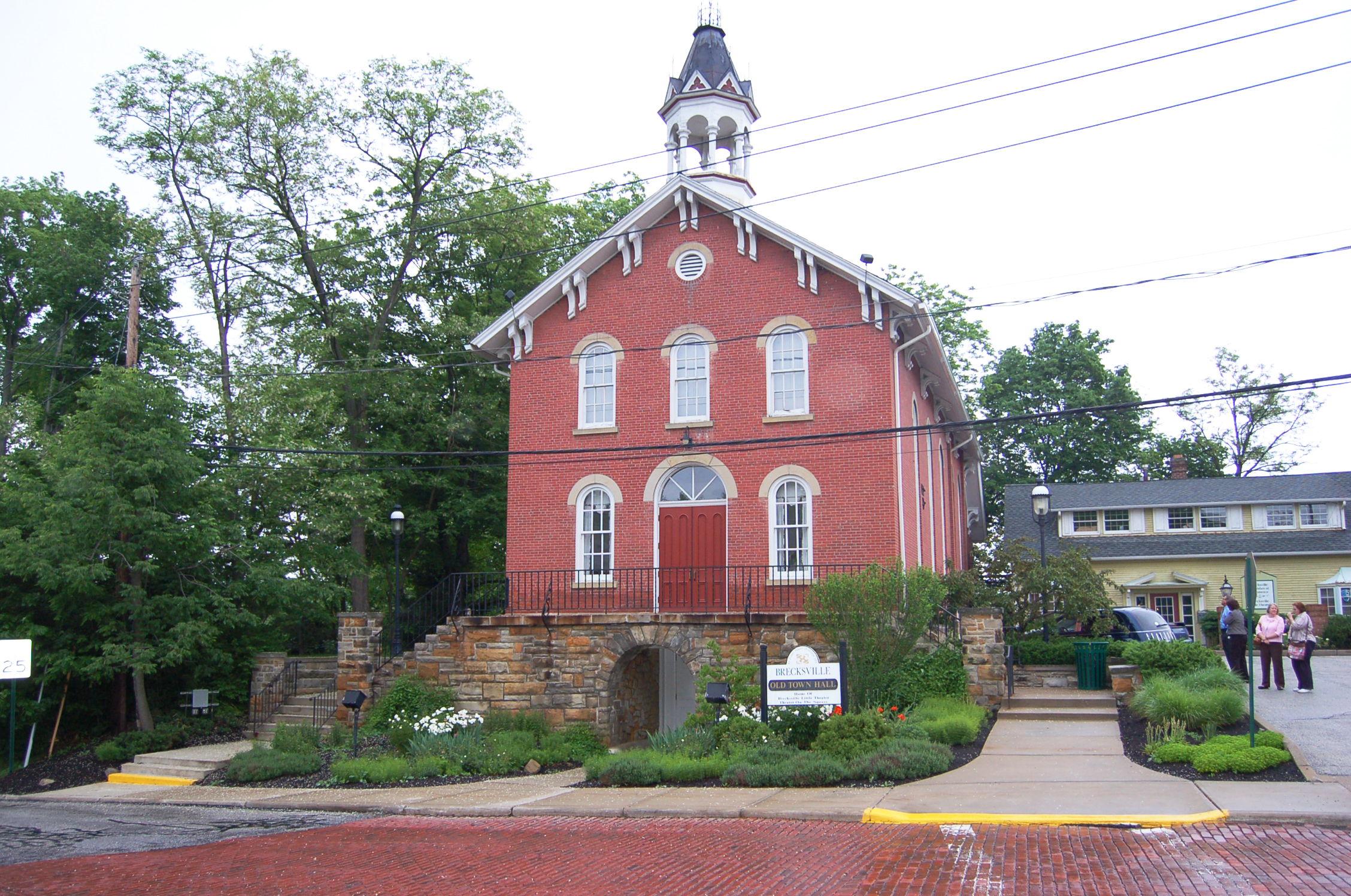
The Brecksville Theatre – Brecksville
The Old Brecksville Town Hall was built in 1874. In the 1940s, performances by the Brecksville Little Theatre began to be held in the town hall building. Paul Newman, yes, that Paul Newman, directed the comedy, Here Today in 1951 there. In 1975, a second theater group, Theater on the Square was established. Tragically, the old town hall was damaged in a fire in 1976, but was repaired. In 2017, it was announced the two theater groups were merging into The Brecksville Theatre and will continue to perform in the old town hall.
The new Brecksville Theatre has several shows lined up this fall. See the schedule here.
The Canton Palace Theatre – Canton
Like The Marion Palace Theatre and The Akron Civic Theatre, The Canton Palace Theatre was designed in a Spanish Colonial Revival style. It is also one of a few surviving atmospheric theatres. The Canton Palace Theatre opened in 1926 as a movie house and Vaudeville theatre. After a period of decline, the theatre closed on its 50th anniversary in 1976 and was soon scheduled for demolition. The Canton Jaycees saved the building and held it in trust until The Canton Palace Theatre Association was formed to operate the theatre. It reopened in 1980 and over $4M in renovations have taken place.
The Canton Palace Theatre continues to show films and have live performances. Their schedule of events can be viewed here.
The Gordon Square Arts District – Cleveland
The Gordon Square Arts District composes three theatres in the Detroit Shoreway: The Capitol Theatre, The Cleveland Public Theatre, and The Near West Theatre.
The Capitol Theatre opened in 1921 as part of the Gordon Square Arcade. As new cinemas arose, the arcade and theatre declined. A parapet collapsed in 1978, damaging both the arcade and Capitol. It was slated for demolition, but the building was saved by the Detroit Shoreway Community Development Organization. The Capitol closed in 1985. It was reopened in 2009 with the help of Ohio Historic Preservation Tax Credits, and become a catalyst toward neighborhood redevelopment.
The Cleveland Public Theatre was founded in 1981. In 1994-95, The Cleveland Public Theatre moved into two adjoining buildings on Detroit Avenue, including The former Gordon Square Theatre building, one of Cleveland’s oldest standing theatres.
The Near West Theatre sprang to life in 1978, using the third-floor ballroom of the St. Patrick Church Club Building as performance space. The newly constructed Near West Theatre building in The Gordon Square Arts District opened in 2015.
Lions Lincoln Theatre – Massillon
The Lincoln Theatre opened in 1915 during the silent era of film. It switched ownership several times during its life as a cinema. By the late 1970s, it was closed and waiting to be demolished. The Massillon Lions Club acquired the theatre in 1982, saving it from destruction. After extensive renovations, the Lions Lincoln Theatre was reopened and continues to entertain audiences.
The Lions Lincoln Theatre currently shows classic films and live performances. To see their current schedule, click here.
The Historic Ohio Theatre – Loudonville
The neoclassical Loudonville Municipal Hall and Opera House opened in 1910, with the opera house located at the rear of the building. The first performance at the opera house was The Flaming Arrow. The opera house was renamed The Ohio Theatre in 1931. Renovations of the theatre are ongoing with fundraising for a new lighting system underway.
The Ohio Theatre currently has live performances and movies. View their current line-up here.
Playhouse Square – Cleveland
Playhouse Square, the “world’s largest theater restoration project,” and the country’s largest performing arts center outside New York City, composes 5 historic theatres: The Allen Theatre, The Hanna Theatre, The Ohio Theatre, The Palace Theatre, and The State Theatre. Playhouse Square draws more than 1 million people annually to its 10 performance spaces while contributing in excess of $43 million in local economic impact every year exclusively from its performing arts activity
The Allen Theatre opened in 1921 as an Italian Renaissance silent movie house. The first film shown at The Allen was The Greatest Love starring Vera Gordon. It continued to show films until it closed in 1968. It was reopened in 1994 and underwent renovations in 1998 and 2011.
The Hanna Theatre opened in 1921 with a performance of Mark Twain’s The Prince and The Pauper. The theatre was designed in French Imperial style. It closed in 1988. It was reopened in 1997 and was fully renovated in 2008.
The Ohio Theatre was designed as an Italian Renaissance theatre. It opened in 1921 with a performance of The Return of Peter Grimm. It closed in 1969 and was reopened in 1982.
The Palace Theatre was opened in 1922 as a French Imperial-styled Vaudeville theatre. It was adapted to show films in 1926. It closed in 1969 and reopened in 1988 as The Connor Palace Theatre.
The State Theatre opened as an Italian Renaissance Loew’s theatre. The first film show was Polly with a Past. The theatre contains 4 murals by James Daugherty and a 320-foot long lobby, one of the longest in the world. The theatre closed in 1969. It was nearly demolished with The Ohio Theatre in 1972, which led to the revival of Playhouse Square. The KeyBank State Theatre reopened in 1984.
To view current events for Playhouse Square, click here.
Southeast
The Markay Cultural Arts Center – Jackson
The Markay Theater opened in 1930 with a showing of Playboy of Paris. The Art Deco theatre features 6 prominent panels depicting life in Jackson. It closed in the early 1990s, but reopened with the help of the Southern Hills Arts Council in 1997. An extensive renovation of the theatre took place and a grand reopening of the theatre occurred in 2015.
Currently, the Markay has several live performances and classic films. For a complete list of events, click here.
Peoples Bank Theatre – Marietta
The Hippodrome Theatre opened in downtown Marietta in 1919 as a Vaudeville theatre and movie house with a showing of the film, Daddy-Long-Legs. In 1949, it was renamed the Colony Cinema. In 1957, it hosted the world premiere of Battle Hymn, starring Rock Hudson. The Colony Cinema had numerous ownership changes and ultimately closed in 1985. The Hippodrome/Colony Theatre Association spent 15 years raising funds for the theatre, including an Ohio Historic Preservation Tax Credit for the project. Peoples Bank Theatre reopened in 2016 and hosted the State of the State address the same year.
Peoples Bank Theatre hosts live performances and film viewings. View their full line-up here.
Stuart’s Opera House – Nelsonville
Stuart’s Opera House opened in 1879 and was named after George Stuart. It continued operating until 1924, when the local coal economy crashed, bring down the opera house with it. In 1977, the Hocking Valley Museum of Theatrical History bought the opera house and began to restore the historic property. Following a fire in 1980, the process of restoring the property was begun anew. The opera house was officially reopened in 1997, after 20 years of hard-fought restoration work.
Stuart’s Opera House offers a variety of live performances to the Nelsonville community. For the current list of events, click here.
Twin City Opera House – McConnelsville
The Twin City Opera House opened in the late spring of 1892 to Gilbert and Sullivan’s “The Mikado”, sharing space in the mammoth building with the McConnelsville town hall. Nearly 20 years after opening, the first silent movies were shown in the opera house, and the first sound system was installed around 1930 using Vitaphone technology. In 1936, the opera house was updated to install sound projectors and renovate the auditorium to accommodate a new projection booth. This was the only time the opera house was closed to the public in its long history.
The Twin City Opera House continues to show films and hosts live performances, including The Ohio Valley Opry. Check full schedule for details of upcoming performances.
The Ariel Opera House – Gallipolis
The Ariel Opera House opened in 1895, just blocks from the Ohio River in downtown Gallipolis. After struggling in the post-WWII era, the opera house closed in the 1960s. Local citizens, led by local professional musician Lora Lynn Snow, banded together in the late 1980s to restore the opera house, and it reopened in 1990, becoming home to The Ohio Valley Symphony. In 2006, the Ariel was rededicated as The Ariel-Ann Carson Dater Performing Arts Centre, after local resident Ann Carson Dater purchased the opera house and presented it to the community as a permanent home for The Ohio Valley Symphony and for use as a performing arts center.
The Ariel-Ann Carson Dater Performing Arts Centre continues to be the home of the Ohio Valley Symphony and has theatrical performances as well. See their current events here.
![]()
Save the Places that Matter to You on #GivingTuesday
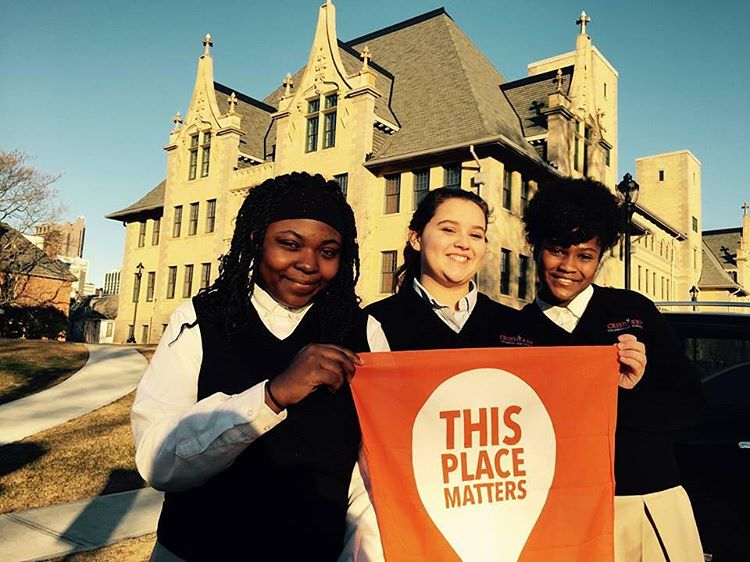
Thank you for being part of Ohio’s historic preservation and community revitalization movement. Like us, you want to save the places where your most cherished memories took place. Whether it’s in your hometown, or the place you call home now, we know how important these places are to you. On #GivingTuesday, November 29th, donate and say, “I want to save the places that matter to me and my family!”
What Your Donation Means:
Saving the Places that Matter – Heritage Ohio has worked to save hundreds of beloved historic buildings throughout Ohio. By returning these treasured buildings to use, we help your favorite small businesses succeed, as well as improve the quality of life in your community.
Building Community – All of us want strong, prosperous communities to live and work in. Heritage Ohio helps communities like yours succeed by using the unique buildings and talent that reside in your town. We provide the information and assistance needed to take the next step and make smart decisions that allow your community to thrive.
Living Better – Heritage Ohio advocates for you and your community at the local, state, and national levels. We are letting legislators and officials know what we need to make Ohio the best place to raise our families, create meaningful careers, and building a better life for all Ohioans.
How to Donate:
You can donate online now by clicking the button below:

If you would prefer to send a check, please mail your donation to:
Heritage Ohio
846 ½ East Main Street
Columbus, OH 43205
GIVE NOW | SAVE THE PLACES THAT MATTER
![]()
Our Preservation Month Photo Contest is open for entries!
Preservation Month is just around the corner…well, OK, still a few weeks off, but, our 7th Annual Preservation Month Photo Contest is now open for entries! We’re looking for great subject matter capturing the spirit of preservation & revitalization in our communities.
And while we’re hoping to capture the spirit of preservation & revitalization, this year we’re also co-opting the #iwanttoberecycled campaign (you can check out the campaign here). So, submit a picture of a great historic building in your community waiting to be recycled, or a photo of a building that has been recycled for a new use and given a new life. We preservationists know that the value of recycling isn’t limited to that plastic shampoo bottle or empty soda can, so let’s broaden the conversation.
When you get that perfect shot, submit it to us. We have a limit of one entry per person, so you have to send us your very best! You can enter here (we have the form at the bottom of the page) or post your entry on our Facebook wall using the hashtag #heritageohiophotocontest. You can also enter through Instagram, again using the hashtag #heritageohiophotocontest. Add the #iwanttoberecycled hashtag, too, and help broaden the conversation about the things we use that deserve to be recycled.
We’ll accept entries through Friday, April 29. Online voting for your favorite finalist begins Saturday, May 7, and closes at 5 PM on Friday, May 13. Our photo contest winner, bringing preservation fame and a featured spot on the cover of Revitalize Ohio, will be announced Monday, May 16.
New this year, when we name our finalists on Saturday, we’ll have in-person voting for a Peoples’ Choice Cash Award at the Old House Fair. The finalist image that receives the most votes (dollars) during voting at the Old House Fair gets to keep their “votes.” So, if you’re at the Old House Fair, check out the finalists and put a buck or two toward your favorite.
Some guidelines to remember: be creative and original with your photo composition…we love photo entries depicting historic buildings in use (or, for this year, historic buildings waiting to be in use); make sure your image highlights Ohio subject matter; and finally, use your best judgment as to whether or not you should get permission from the building owner before photographing your subject matter.
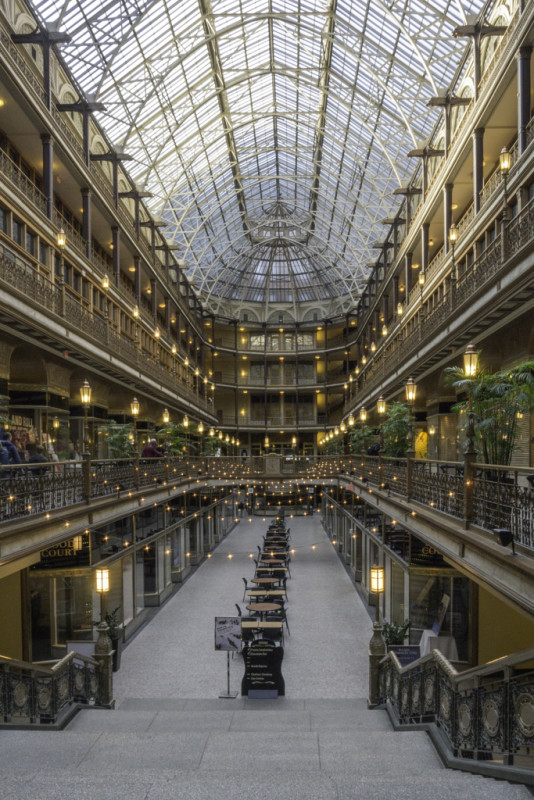
Our 2015 winner, Judith Khaner, captured the architectural beauty of The Arcade in Cleveland
Good luck!
Sorry. This form is no longer available.
![]()
What do you geek out over?
We all have something we geek out over, something we could spend hours looking at or studying. Maybe for you it is house colors, baseball statistics, the next way you might design your garden. For me, I regularly have what I call nerd nights where I pick a city and look at the Sanborn Fire Insurance maps. Sanborn maps are probably my favorite historic resource to consult and for this blog post, I am going to share why I get so excited when I find Sanborn maps.
Sanborn maps were created as a risk analysis tool for insurance underwriters. The maps were produced from 1866 through 1970. Population growth, demographic shifts, and urban sprawl all necessitated the need for regularly updated maps. A new map was created approximately every 10 years. The maps were created for towns and cities, but are generally not available for country properties. For the bigger cities, like Columbus or Cleveland, multiple volumes were needed to show the entire city. New York City reportedly has 39 volumes.
What’s so special about these maps? The wealth of detail and information which can be gained about a building for which there are no photographs can often be found in these maps. Each map was created on a piece of paper measuring 21” x 25” and was drawn at a scale of 50 feet to 1 inch. Everything was measured by tapeline, including the buildings, streets, sidewalks, and other utility features like distance to fire hydrants, gas lines, and water lines. The last part was particularly important for the fire insurance aspect of the maps. While the maps were created across the country, all maps are set up the same; all keyed the same, and demonstrate the same level of detail. Each volume was set up in the following order: a decorative title page, index of streets and “specials” which included schools, churches, and bigger businesses, a master key for the map (a map of the entire city color coded and numbered showing which map you would need to look up for your particular address), and some general information on population, geography, geology, economy, etc. In the case where multiple volumes were needed for a city, the master map would also let you know the volume number you needed if the area was adjoining the map you were currently using. Many states, including Ohio, have indexed digitized copies of the maps. If you have a library card, you can access this database (yes, even from your home in your comfy clothes). Here’s the link http://sanborn.ohioweblibrary.org.oh0057.oplin.org/ unfortunately, most of the digitized maps are black and white, but a lot of information can still be gained.
For this example, we will look at Heritage Ohio’s location. If you’ve never been to our office, feel free to do a quick Google maps street view search so you can get a 2014 idea of what the neighborhood looks like today. Our address is 846 East Main Street, Columbus. Click on the sanborn.ohioweblibrary link from above and type in Columbus on the search box. Now we have a list of the maps which have been digitized for the city. Notice that the first two years only have a single volume, then in 1901 there are 3 volumes, 1921 there are 6, and then in 1951 there are 9 volumes.
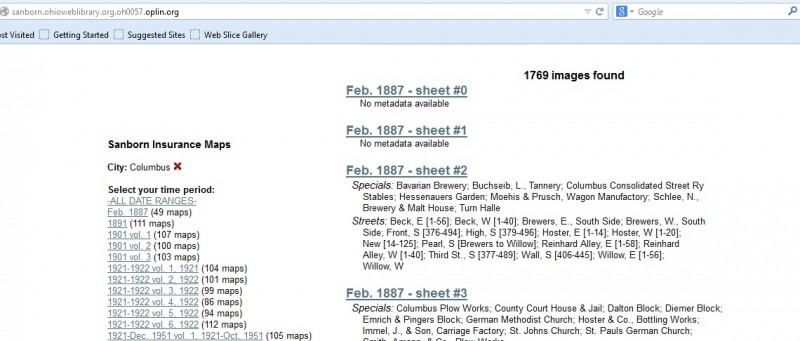
Go ahead and click on 1887. This will bring up a hyperlink for each map and also lists the “specials” and the streets (including the street numbers represented on that map). We want the street titled, Main, E which includes 846.

One of the first pages (usually page 0a or something similar) will always be the index, which if there were multiple volumes for the map would let us know if we were in the correct volume. In this case, the index is the first link. Clicking on the link, we find that there was a gap in the mapping between 824 and 893 East Main Street. Rather irksome knowing they cut off right where you need the map! So, click the red ‘x’ next to the Date: Feb, 1887 on the left side of the screen and it will bring you back to the list of maps.
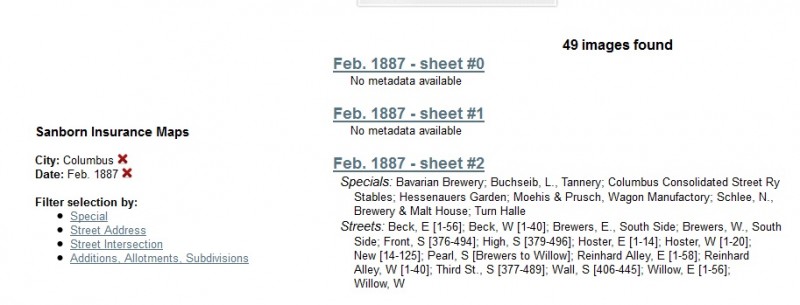
Let’s try 1891. The index tells us that we need sheet number 70. On the right side of the screen, you can “jump to” a specific page. Go ahead and type in 70 and check it out. You should be able to zoom in to read the tiny details. If you had a chance to drive by our office or street viewed the neighborhood, you would know there is a square block of nothingness across the street from us. However, now you know what used to be there….an orphan asylum, and a large campus at that! The next map available is from 1901. I’ll save you the time and let you know you that our address is in Volume 3, sheet 320. Compared to the last map, we can see there has been a lot of development on our block. Our building is at the bottom of the sheet, where 844 and 848 are labeled. Yes, the one with the attached bowling alley. Focusing on this parcel of land, this map shows us that the building was 2 stories, with an opening to get between 844 and 848 in the middle, as well as access to the bowling alley. Keep going and find out what else became of the block. What became of the orphan asylum?
The color coded maps, in my opinion, are well worth the trip to the library or historical society. Here are the links for the keys so you can decipher the map. For the black and white maps, like the digitized maps mentioned in this blog, use this key: http://sanborn.umi.com/HelpFiles/bwkey.pdf
Here is a color coded key: http://www.loc.gov/rr/geogmap/sanborn/images/sankey22c.jpg
Here is a link for the many of the abbreviations found on the maps: http://www.newberry.org/sites/default/files/researchguide-attachments/sanbornabbrv.pdf
Tales From a Privy Shaft Part 2
This blog post is part 2 of 3 telling the story of urban archaeology in a Cincinnati neighborhood. All information is credited to the archaeology report, “Queensgate II: An Archaeological View of Nineteenth Century Cincinnati,” by Thomas Cinadr and Robert Genheimer. The first part of this story left off discussing the process Cinadr and Genheimer used in selecting the lots. Especially when it comes to urban archaeology, it is important to remember site activity occurred not only in the house, but the entire lot. While today we throw meal leftovers and unneeded parts down the disposal or in the garbage can, get our water from the pipes in our house, and use the toilet in the bathroom, prior to the 20th century these were outdoor activities. Excavations to expose these activities and the differences between classes were the main objectives of this investigation. This blog will focus on the history of each lot and the excavation of each feature by Miami Purchase Association. The history of each lot was provided by Stephen Gordon and Elisabeth Tuttle’s 1981 study, “Queensgate II: A Preliminary Historical Site Report.”
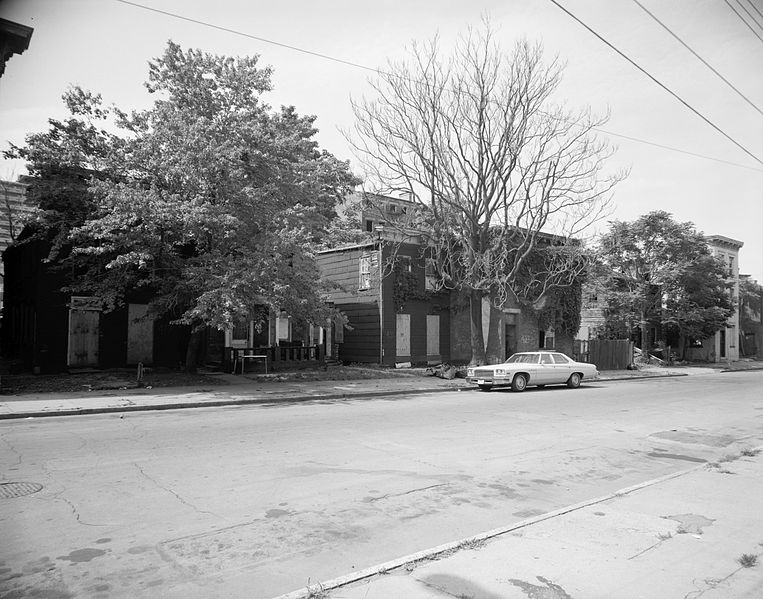
Betts Longworth Historic District (formerly Queensgate II) taken July, 1982.
Library of Congress, Prints & Photographs Division, OHIO,31-CINT,20-2
425 Chestnut Street
Cyrus Dempsey purchased this lot in 1847, and a house was built by 1849. Cyrus’ wife, Sarah, was a schoolteacher, and following Cyrus’ death Sarah remarried and remained in this house. Her new husband worked his way up from a copyist to a bookkeeper. In 1868, a new middle-class family moved in here and remained until 1900. After this family, a German immigrant family moved into the house and remained there until 1941. Three families called this place home in the span of just over 90 years. After 1941, we see a change towards the working class and a noticeable transient type of tenant; 6 tenants in 26 years. The house stood vacant from 1969 until 1981, and was demolished the following year.
Archaeologists from Miami Purchase Association used a heavy duty pry bar was used to lift the massive concrete slab covering the privy shaft. A layer of 20th century debris was cleared and a brick pad was found. Beneath that was the circular limestone outline of the privy shaft. Much of the upper portions of the privy shaft contained ash and heat altered materials, butchered bone, and 20th century bottles and ceramics. After about 10 feet, there is a change from solely kitchen dumping material to the introduction of a loose brown seed filled matrix (decayed fecal material) intermixed with the kitchen refuse. According to Cinadr and Genheimer, the artifacts suggest that the deposit dates between the 1880s to early 20th century.

A new level was formed every 12 inches. A new horizon is formed as the soil changed. Credit: http://en.wikipedia.org/wiki/File:Estructura-suelo.jpg#filelinks
Cinadr and Genheimer explain heavier amounts of 19th century glass and ceramics were uncovered in the next level below. Moving through the following three feet, there was still good evidence for kitchen refuse activity in addition to badly corroded metal and some glacial soils. The next horizon (layer of activity change) is confined to Level 14 and has heavy amounts of fecal material as well as architectural materials and kitchen refuse. Towards the end of this level, a gray clay matrix, followed by sand was found, indicating the Wisconsin Outwash and the bottom of the feature. Unlike the other privies studied by Cinadr and Genheimer, the diameter of this perimeter started at 3’8” and decreased with depth, ending at 2’3” at the base.
427 Chestnut Street
Next door stands a three story brick building. Archival research by Gordon and Tuttle (1981) shows that a frame house built sometime between 1848 and 1850 was standing in 1855. The current brick house replaced the frame structure by 1858. James Porter (a house painter) and his wife are first listed at this address in the 1849 city directory. A servant was listed in the 1880 census, but only for that year. James Porter passed away in 1889, and their grandson, E. A. Ferguson (16 years old) moved in with James’ wife, Margaret. He became a clerk and later a traveling salesman for a book company. In 1898, Margaret passed away and a man named Charles Dustin, listed as a night watchman, moved in. The mystery of Charles will play out later, but he is an example of unexpected mysteries uncovered during archaeology. The occupants of the house are unknown from 1901-1909. The next occupants listed began a line of working-class and African American tenants. While some stayed longer than others, there was significant movement in and out of the house by single males, mostly listed as laborers, which could suggest that people went where there was work. By 1981, the house was vacant.
A 13.5’ by 16’ addition once stood at the rear of the house, and is now covered by a concrete pad. Archaeologists removed the pad and found a dinner fork inscribed, “Extra Coin Silver Plate 1902.” Further testing revealed a laid brick pad, underneath which was a circular brick privy. Two large concrete slabs were found at the center of the shaft, indicating it was capped. Below that, excavations began. The way this privy shaft was used can be seen in the depositional patterns. Cinadr and Genheimer highlight three main activities which this privy was used for: dumping place for construction activities, kitchen refuse dumping, and as a toilet facility. The upper levels had horizons of solely kitchen dumping, as marked by butchered bone, shells, and ash from cooking byproduct. They point out the point in the depositional history where it is likely that indoor plumbing was installed. Below that point, kitchen dumping and fecal material are intermixed. The heavier the density of artifacts and the larger the horizon, the longer the privy was used for that function. The other activity found in the depositional history is construction. Using diagnostic artifacts including nails, coins, and bottles, dates can be narrowed for depositional activity.
The cistern, however, presented quite a different story for Miami Purchase Association. Beneath a large, thin concrete pad was an intact brick patio. Soon after beginning excavations, it became clear that this feature was a brick lined beehive cistern. Cinadr nad Genheimer explain that while it wasn’t surprising to find a cistern close to the house, it was somewhat surprising to find two walls extending from it to the north and the west. The wall extended from approximately three feet south to the eastern part of the cistern. After further excavations, it was determined that these walls belonged to the former addition. Due to the massive volume of soil and artifacts uncovered from within the cistern, a sampling method was enacted. Every fifth bucket of soil was screened for the first level, and every 10th bucket was screened after that. Hand trowling insured that whole bottles, bottle bases and tops, large bones, and larger artifacts were collected, while avoiding the substantial amounts of broken glass, and badly corroded metal. The next horizon was full of white ash with few artifacts. After the 4th level was reached, the walls no longer remained stable due to increasing dampness. Based on the dimensions, it was calculated that 3,180 gallons of water could be stored in this cistern.
In order to refine a construction date for the house, a builder’s trench was excavated below the front porch of the structure. Two feet below the surface, two large cut limestone slabs sitting parallel to each other were found. Below them, an intentionally laid brick area forming an arc was exposed. One possibility presented by Cinadr and Genheimer was the possibility that the limestone slabs were originally stairs, and once they became unstable, a wooden porch was constructed. Excavations point to two distinct periods of construction. It appears that Levels 1-4 (the upper 4 feet of the excavation) were considerably disturbed after construction of the house. The second period of construction was that of the house itself. Based on the artifacts identified, the dumping activity was unspecialized. Artifacts included a mix of kitchen refuse, marbles, buttons, a few coins, bottle glass, several ceramics of varying types, and architectural material, all dating to the mid-19th century.
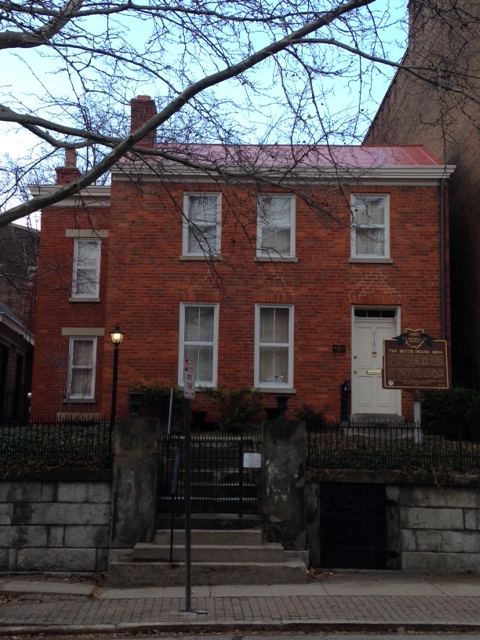
416 Clark Street
This property, more commonly known as the William Betts House, was the beginnings of Queensgate. The brick house was built in 1804, with a brick and frame additions created at separate times but are known to pre-date the neighboring 1878 house, and a metal addition constructed in the 20th century. An early kitchen addition was badly damaged in the 1811 New Madrid Earthquake. The Betts family lived in the house until 1825, with 100 acres of the 111 acre property being split up and going to auction in 1833. It is thought that the privy currently on the property was constructed at this time. The 11 acres which were not sold included the 1804 house, which continued to be lived in by the Betts family until 1849. Dr. Alex Johnston and his family lived in the house during the 1850s and into the 1860s. The house remained part of the mercantile society until the turn of the century, when the occupants would more likely be considered middle class. Unlike the other two houses, the occupants were families who remained in the house for much longer periods. The house was occupied until 1981, when it stood vacant.
Clearing of a feature identified during the survey work revealed a large rectangular limestone lined walled feature which went right up to the foundation of the neighboring property. The privy fill was clearly disturbed for the first four feet. This all became known as Level 1. The privy shaft took a circular shape 4.2 feet in diameter by the next level. Artifact densities are light until the end of Level 3. After this, a large deposit of kitchen refuse (over 300 butchered bones), a variety of bottles, clay pipes, and medicine bottles including a Paine’s Celery Compound bottle were found. Based on diagnostic artifacts, this deposit dates roughly around the turn of the 20th century. A brick stabilization wall divided the privy shaft in half from Levels 4-7, with a portion of a wood beam at the bottom. Ash deposits surrounding the wall and arch fall continue through Level 13. Moderate densities of artifacts including flower pots, lamp glass, rubber combs, flavoring extract bottles, metal, electrical wire, window glass, sewing machine oil, tin cans, celluloid, leather shoes, clay pipes, and a variety of ceramics, medicinal bottles, and butchered bone were found within the ash deposits. Temporally sensitive artifacts place this portion of the privy at mid 1890s. As the excavation progressed, it was noted that fragments from a single artifacts were found in several levels. For example, fragments from a badly shattered brown spongeware teapot were found in Levels 6, but also in Level 14 (8 feet further below). Excavations ceased at after Level 19 due to decreasing stability of the walls and cold temperatures. The southern half of the privy shaft was excavated (unscreened) to 24’6” and then a 5 foot soil core was used to determined if any changes in soil would occur. The same types of artifacts were encountered until the bottom 2” of soil, which contained a dark seed-bearing level (likely fecal matter). Cinadr and Genheimer note that it appears this privy was quickly filled around the turn of the 19th century. The privy shaft was likely not capped until after 1959, as mid-20th century artifacts including a 1959 dog tag were found in the upper levels.
An attempt to locate depositions related to the construction of the house was made with a 3’x6’ unit next to a wall of the original portion of the house. A small assemblage of a mix of 19th and 20th century artifacts were located in the first level, including portions of a Diet 7-up bottle near mid 19th century ceramic shards. The next level below included architectural artifacts, as well fragments from an aqua glass bottle embossed Dr. D. Jayne’s Oleaginous Hair Tonic, whose business began in 1839. A thin gray clay material was noted near the foundation of the house from Level 1 until Level 4, extending out from the house up to 13” and then retreating back to the 3” from the foundation in Level 4. A variety of construction material, early 19th century ceramics, and a fragment of prehistoric chert, along with a small chert projectile point were found in the horizon next to the clay material. The foundation was made of undressed limestone slabs, which stops short of extending to the basement floor. Based on the artifacts uncovered, Cinadr and Genheimer explain that it is likely that this building trench dates to the construction of the original house and was undisturbed after the first level.
The last portion of this story will focus on the analysis of the artifacts and the results from Cinadr and Genheimer’s excavation. Today the William Betts house, at 416 Clark Street, is open as a museum. Learn more about the Betts family history and their house check out The Betts House.
Tales From a Privy Shaft part 1
Passing through downtown neighborhoods, many of us will notice the historic houses. Some are still as beautiful as the day they were completed and some are diamonds in the rough. Even driving through the dilapidated areas, I’m sure many of us wonder what the neighborhoods looked like in their prime. While the buildings are beautiful, I have always been attracted to the story behind the building. The story of who lived there, what the children played with, the health concerns of the former tenants, consumerism patterns and the story of the built past can be told through archaeology. Archaeology also can present new, untold stories, as we will see play out in the excavation of one of the privy shafts in the Queensgate II excavation. Since this project has so much detail and so many stories, it was necessary to split it into 3 blog posts.
How the Project Began
The Queensgate II neighborhood of the 19th century was substantially different than the Queensgate II of the late 20th century. The once thriving, diverse, highly populated area, had become a memory. With urban housing projects to the north, a booming business district to the east, and a freeway to the south and west, it is no surprise that by 1968, the population of this area was a mere 1280. The Queensgate II archaeology project was born from Ted Sunderhaus’ observation that despite excessive amounts of “excavations” by looters, and the vast amount of vacant buildings, there were still several areas which could provide the archaeological features necessary for the study of this diverse 19th century neighborhood. The Miami Purchase Association (now known as the Cincinnati Preservation Association) approached the City of Cincinnati with a plan to incorporate the results from an urban archaeological study into the mitigating factors of nearby redevelopment plans. The project was restricted to properties owned by the City of Cincinnati, within a five block area. The year prior, a detailed lot-by-lot history, which shed light on the class diversity, was conducted by Stephen Gordon and Elisabeth Tuttle. The archaeological research would provide additional insight on this topic.
Neighborhood Beginnings
The area known as Queensgate II (now known as the Betts Longworth District) is a 7-block, 117 acre area of Cincinnati bounded by Ezzard Charles Dr., Race Street, 6th Street, and I-75. Streets began being laid out as early as 1815 and a building boom followed the next decade. The city’s population tripled during the 1840s, and a change from frame construction to brick construction followed. Most people in the Queensgate II neighborhood were from New Jersey, Ohio, and Pennsylvania, and were generally prosperous merchants. By 1870, however, a large German influx moved in and the original inhabitants moved away. Tensions between the Jewish population and non-Jewish population were common. In 1918, 55% of Cincinnati’s Jewish population lived in the West End (an area which includes Queensgate II). By 1930, however, only 5% remained. Also noteworthy was the increase in the black population. The 1860 census only listed 80 black people in the Seventh Ward, but by the 1920s, as much as 80% of Cincinnati’s black population lived in the West End. Demolition of Lincoln Park for Union Terminal in the 1930s, construction of the Interstate, and government housing drastically altered the streetscape.
Lot Selection
Since Queensgate II provided such a heterogeneous population, it was an ideal setting for the study. Preliminary surveys included looking through the back dirt left behind by looters, which were found to have a representative cross section of the past inhabitants with a wide array of artifacts recovered. Between the data provided from the Gordon and Tuttle report and a reconnaissance survey to identify potential features, along with factoring in economic diversity, potential for an intact feature, and the completeness of the historical record, selections for sites to be excavated was made.
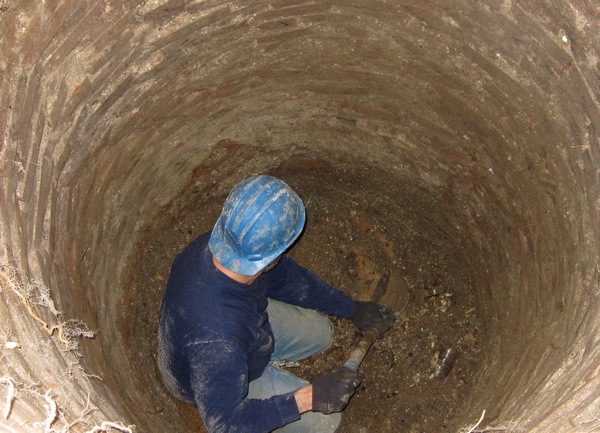
A brick-lined privy shaft being sampled in Manhattan. Credit: http://en.wikipedia.org/wiki/File:Bricklined_privy.jpg
Two lots were chosen, based on the selection criteria. The first held an 1840s frame structure and held an intact privy and cistern. Thorough documented history, including city directories which listed occupation for each resident, for this lot and the neighboring were found. The second location selected was the William Betts house. Similarly, a thorough history, intact privy and cistern were found on the lot. Additionally, it was decided that at least one builder’s trench be excavated to provide additional information.


